September 9th, 2011
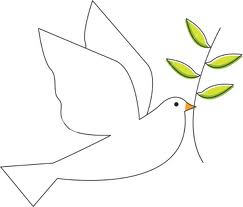
At a time when the Tasmanian Government has a protracted budget crisis, when Gunns and its logging venture is on the brink of financial collapse, and the Australian Federal Government is offering a $276 million package to the Tasmanian logging industry to transition out of subsidy-dependent logging; this is a time for strategic decision making. This is a time for considering the next generation of Tasmanians.
The days of governments providing subsidies to forestry are numbered. The writing is on the wall for multi-national/industrial hardwood forestry in Tasmania.
Despite the less than perfect negotiations, the undemocratic secrecy of the deal making, State and Federal governments’ poor grasp of change management, Tasmanians are presented with an olive branch. The last time a middle-ground opportunity was available to the two warring sides was the 1989 Salamanca Agreement which was quickly scuttled by government. A generation later, a considerable financial incentive and the facilitation of transition out of logging are on the table.
Irreplaceable old growth forest ecosystems are at stake, but equally at stake are rural livelihoods. There are structural social repercussions that will last decades. But then Tasmania’s poverty is already structural. It has become inter-generational and Tasmanians need a transitional direction out of poverty. While mindful of the recurring history of conflict and community polarisation, this current opportunity for change is rare and perhaps a once in a generation one at that.
In order to begin to appreciate the cultural depth of Tasmania’s ‘age-old conflict‘, at least four particular books should be read on this history:
- ‘The South West Book: A Tasmanian Wilderness‘, compiled by Helen Gee,Janet Fenton and Greg Hodge in 1978, published by William Collins Pty Lts and The Australian Conservation Foundation [Read More]
- Helen Gee’s 2001 book ‘For the Forests: A History of the Tasmanian Forest Campaigns‘, published by The Wilderness Society, Inc. [Read More]
- Greg Buckman’s 2008 book ‘Tasmania’s Wilderness Battles: a history‘, published by Allen & Unwin [Read More]
- Anna Krien’s 2010 book ‘Into the Woods: the battle for Tasmania’s Forests‘, published by Black Ink [Read More]
.
Perhaps as an interested outsider, a mainlander, I can consider this Tasmanian-wide conflict from a detached unencumbered perspective. The younger generations have opportunities that their parents and ancestors never did. Had my grandfather not died on the farm when my father was just eight years old, I may well have followed generations into sheep farming. My grandmother with her only child left the farm to give my father the best opportunity she could. I reflect on that opportunity and the greatly increased opportunity that my parents have provided me and my siblings. It takes one opportunity, for others to become available and sometimes it takes generations.
While not setting out to be critical of sheep farming per se, in hindsight sheep farming in Australia over my lifetime has become low margin and commoditised (like woodchips) and many a wool grower have not experienced the anticipated opportunities flowing on from the halcyon days when Australia was built off the sheep’s back. ‘Once a great nation-building icon, the wool business today is but a third of its size when Australia ‘rode on the sheep’s back’. Compared to the more recent Australian Wheat Board scandal, 40 times more funds were lost in the downfall, and vastly more collateral social and economic damage was done in this country and across the globe.’ Indeed, Charles Massey’s 2011 book ‘Breaking the Sheep’s Back‘ tells the untold story of the events that led to Australia’s biggest industry disaster. [Read More].
Just as Australia’s traditional wool business has declined, so too has Australia’s traditional timber business.
‘Most of the change we think we see in life is due to truths being in and out of favor.’
~ Robert Frost’s 1915 poem, ‘The Black Cottage’.
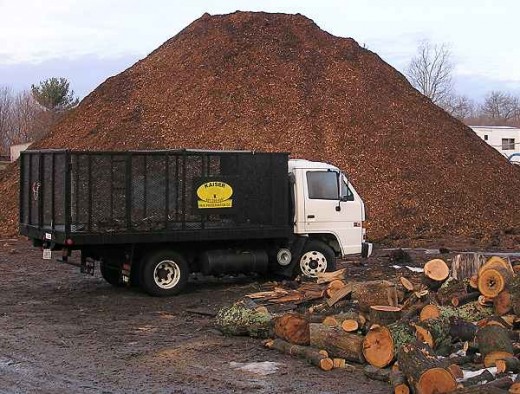 Woodchipping Tasmania only benefits foreign buyers, who must be laughing Woodchipping Tasmania only benefits foreign buyers, who must be laughing
.
Once island problems are recognised for what they are (internal island problems), the quicker more Tasmanian’s will recognise that the future challenges and opportunities of the island lie with industry diversification, value adding produce and services and with the world outside it. Trading internationally directly is where Tasmania’s future prosperity lies. Tasmania can learn much from the pure brand of ‘New Zealand’. Much of Tasmania’s output competes in comparable industries with the output of New Zealand.
Past and current generations of Tasmanians have become familar with old growth forests and many have become complacent of their presence. Future generations have a right to that familiarity.
Tasmanian complacency was the root cultural cause behind the eventual extinction of the Thylacene.
 Extinction is forever ~ the dark past should not curse our future Extinction is forever ~ the dark past should not curse our future
.
“Tasmania is slowly evolving towards goals we cannot now see. If we can revise our attitudes towards the land under our feet; if we can accept a role of steward and depart from the role of conqueror; if we accept the view that man and nature are inseparable parts of a unified whole – then Tasmania can be a shining beacon in a dull, uniform and largely artificial world”.
~ Olegas Truchanas, 1969
[Source: ^http://florentine.org.au/]
.
.
Intergovernmental Forests Agreement, 2011
.
In October 2010, the major breakthrough in the almost century long dispute over Tasmania’s forests was reported secured in principle between the key parties, Tasmanian timber communities, forest unions, and industry, Gunns, Environment Tasmania, the Conservation Council, The Wilderness Society, Australian Conservation Foundation. Credit is due to the two instrumental negotiators, Gunns chief executive Greg L’Estrange and forest facilitator Bill Kelty.
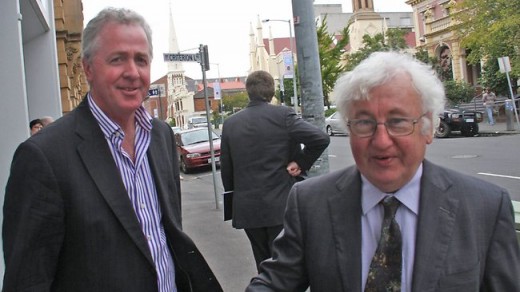 Tasmanian History in the making Tasmanian History in the making
.
The aim was to find an agreement develop a more sustainable timber industry and to end logging Tasmania’s remaining valuable native forests. It will mean an end to logging of native forests will also protect critical habitats for Tasmanian devils and other threatened species. A moratorium on the logging of high native forests will be phased in over three months, while maintaining essential supplies for necessary timber mill operations.
The “Tasmanian Forests Statement of Principles” were agreed to set Tasmania’s timber industry on a new path to economic opportunities through plantation-based forestry, protecting timber worker’s jobs and native forests.
.
.
“The forestry industry, unions and environment groups have found common ground in the interests of all Tasmanians. This will pave the way for a sustainable timber industry that protects jobs and also protects the state’s remaining unique native forests,” said Environment Tasmania’s Phill Pullinger..
.
[Source: ‘Forests: Peace in our time?’, by Andrew Darby, The Age, newspaper, 20101019, ^http://tasmaniantimes.com/index.php/article/peace-in-our-time]
.
.
.
Tasmanian Transition from High Volume/Low to Low Volume/ High Value Add Timber – public debate recommended
.
While not advocating industrial logging of Tasmania’s native myrtle, a refocus from high volume/low margin woodchips toward low volume / high value specialised timbercraft is a Tasmanian industry that has potential to be both commercially viable while being ecologically sustainable, if excluding old growth and so long as it is appropriately tightly controlled and monitored.
A public debate on this potential is recommended.
 High value-add Electric Guitar in Tasmanian Myrtle
[Source: ^http://tasmaniantonewoods.com/guitars] High value-add Electric Guitar in Tasmanian Myrtle
[Source: ^http://tasmaniantonewoods.com/guitars]
.
.
Further Reading:
.
‘Gunns rejects crucial financial offer’
.
[by Andrew Darby, The Age newspaper, 20110906, ^http://www.theage.com.au/national/gunns-rejects-crucial-financial-offer-20110905-1ju9j.html]
.
‘Troubled forestry company Gunns has rejected a financial offer from the Tasmanian government seen as key to the future of the state’s timber industry. The settlement for exiting native forest logging was critical both to Gunns’s future operations and to a landmark forests peace settlement.
”The state government has been formally advised by Gunns Limited of their decision to reject our offer of commercial settlement,” a spokesman for Premier Lara Giddings said yesterday.
The settlement was needed to unlock funding for contractors squeezed by the exit from native forests in a $276 million federal-state package. Rejection comes with Gunns into the fifth week of a stock exchange trading halt, called for the settlement negotiations, with its share price at an all-time low of 20.5¢. The settlement, covering tens of millions of dollars, was meant to extinguish Gunns’s legal rights over native forest contracts with Forestry Tasmania.
.
.
.
‘Tasmanian Forests Agreement (official announcement)’
.
[Source: The Australian Government, 2011, ^http://australia.gov.au/content/tasmanian-forests-agreement]
.
‘The Prime Minister and the Tasmanian Premier have announced a $276 million funding package to support the adjustment of the Tasmanian forestry industry, and to create a significant conservation benefit by reserving and protecting High Conservation Value native forest areas. The Tasmanian Forests Intergovernmental Agreement is designed to support the forest industry to progressively transition to a more sustainable and diversified footing and to build regional economic diversity and community resilience.
The agreement includes:
.
Support for workers, contractors and communities
- Up to $25 million to provide immediate employment and training support for redundant forest workers
- Intensive support through Job Services Australia and other providers relocation support for redundant forestry workers
- $15 million for transition support payments (through ForestWorks)
- $1 million over two years for mental health counselling and community well-being services (through Rural Alive and Well)
- $45 million for voluntary exits from public native forest operations for haulage, harvest and silvicultural contractors.
Tasmanian forest industry workers can call the Tasmanian Forest Support Information Line on 1800 648 075 for more information about the services and payments that may be available to them.
Protecting high conservation value forests and ensuring sustainable wood supply
- Guaranteed annual sustainable timber supply of at least 155,000 cubic metres of high quality sawlog per year and 265,000 cubic metres of peeler billets each year
- Provision for speciality timber, noting that the industry claim is 12,500 cubic metres per year, subject to verification funding to support an independent verification process
- Funding for a voluntary sawlog contract buy-back program for sawmillers wishing to exit the industry
- 430,000 hectares of native forest immediately placed into Informal Reserves
- Legislation no later than 30 June 2012 to formally protect the areas of reserve determined by the independent verification
- $43 million to implement this Agreement (including at least $5 million to support provision of information and consultation with affected communities)
- $7 million per year to support management of additional reserves.
Economic diversification
- $120 million over 15 years to fund regional development projects
- Development of a process to identify by mid 2012:
- the impacts of forestry adjustment on affected regions, including the scope for
- alternative sectors and jobs to support regional adjustment
- progress in implementing Commonwealth and Tasmanian adjustment measures
- the need for further regional development assistance
- A major research and analytical project to underpin this process.
.
.
‘Giddings acts to avert budget crisis’
[Source: Brand Tasmania Newsletter, March, 2011, Issue 114, ^http://www.brandtasmania.com/newsletter.php?ACT=story&issue=114&story=1]
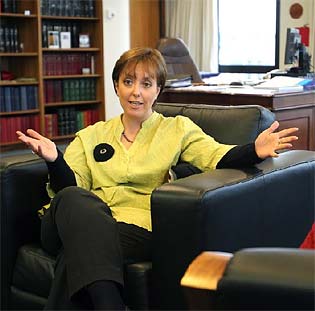 Tasmanian Premier and Treasurer, Lara Giddings
Photo courtesy of The Hobart Mercury
Tasmanian Premier and Treasurer, Lara Giddings
Photo courtesy of The Hobart Mercury
.
As unemployment figures for January showed a monthly rise from 5.0 to 5.6 %, the Premier and Treasurer, Lara Giddings, foreshadowed a 3 % cut in public sector spending and warned Tasmanians to expect three tough Budgets as the State’s balance sheet is shifted back into the black.
Releasing the Mid Year Financial Report on 10 February, Ms Giddings said several 2010 elections promises would have to be scrapped in the drive to off-set an $800 million loss of revenue. She outlined the following immediate savings:
- $97.5m cancellation of equity transfers to GBEs;
- $30.9m scrapping of planned Helicopter Emergency Medical Service;
- $18.0m shelving of proposed Cosgrove Specialist Sports School;
- $ 3.8m dropping of the Events Attraction Program;
- $ 2.0m closing down the Renewable Energy Loan Fund
- $ 3.9m deferring IT projects over two years; and
- $ 2.5m cutting ministerial and parliamentary office expenditure.
“These savings will improve the Government’s financial position in the short term while longer-term structural changes are being developed and implemented,” Ms Giddings said.
She told a media conference the savings needed were the equivalent of 2,300 jobs and she could not rule out forced redundancies in the public service, nor cuts to frontline services. Unions immediately branded her as the first Labor Premier in history to announce public service sackings.
.
“I want to be open and frank with people about the problems we are facing,” Ms Giddings said.
“We are in a place where we need to see significant action to avert a crisis. This is not a crisis; this is an unsustainable situation that will lead to a crisis if action isn’t taken now.”
.
[Editor’s note:
To the contrary, a ‘crisis‘ in a governmental context is defined by the Merriam-Webster dictionary as:
“an unstable or crucial time or state of affairs in which a decisive change is impending; especially : one with the distinct possibility of a highly undesirable outcome <a financial crisis>“]
.
The number of people on the State Government payroll has increased 24 per cent this decade to 25,000 – almost one in every nine employed Tasmanians. Economic commentator Saul Eslake has pointed out that it costs public employees 14 per cent more a year to deliver services to each citizen, compared with their counterparts in Victoria.
So the Government expects job cuts, spending cutbacks and increased efficiency in the public service to contribute $270 million of the $420 million it hopes to save over the next four years.
Ms Giddings said it was regrettable that some worthwhile Government programs could not be continued, but strong action was needed in response to falls in GST revenue and other income in the wake of the global financial crisis. “I am determined to take the steps necessary to protect the Government’s financial position,” Ms Giddings said. “While I would prefer not to have to take some of these measures, I believe they are essential if we are to avoid sliding back into net debt.”
A Sensis Business Index released in late February reinforced the need for decisive action, Ms Giddings said. “The national downturn in retail trade is a concern the State Government shares with local retailers, as it continues to directly impact upon the State budget through reduced GST receipts.”
.
[ Read More]
.

– end of article –
.
Tags: Bill Kelty, Forest Reserve Map, high conservation value forests, Intergovernmental Forest Agreement, Tasmanian Budget Crisis, Tasmanian complacency, Tasmanian Forests Statement of Principles, Tasmanian logging, Woodchipping Tasmania
Posted in Tasmania (AU), Threats from Deforestation, Threats to Wild Tasmania | No Comments »
Add this post to Del.icio.us - Digg
Leave a Reply
You must be logged in to post a comment.
September 5th, 2011
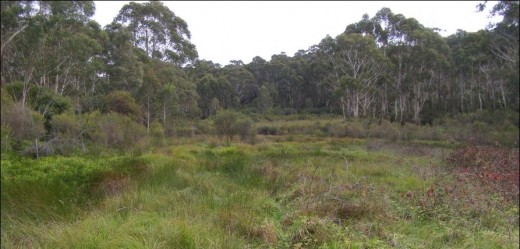 The Gully Water Catchment (Photo by editor 20110502, copyright free in the public domain) .
The Habitat Advocate’s raison d’être
Habitat Campaigning best starts close to home. If everyone took this approach then the natural environment would be far more intact, the wildlife habitat more viable to sustain local wildlife, and the risk of species extinction far lower than where current trends are heading.
The Habitat Advocate established as a volunteer conservation group back in 2001 on the edge of a small steep creek valley within what we term The Gully Water Catchment based at The Habitat Advocate founder’s residential home on the bushland fringe of the regional township of Katoomba, situated in the central Upper Blue Mountains of New South Wales in Australia.
The reference to this creek valley as ‘The Gully‘ is the historical affection name for the valley by former resident tenants.
Our raison d’être (purpose in forming) initiated on one Saturday morning within a few weeks of the founder, Steven, moving into his recently acquired house and suddenly being impacted by the roar of racing Mini Cooper cars down in the creek valley less than 100 metres away. Having had all due diligence in conveyancing previously undertaken ahead of purchasing the property and the previous tenant advising how quite the area was, no mention had been made of the deafening motor racing circuit! Local Blue Mountains [city} Council (local council) maps had labelled the small surrounding valley as ‘Katoomba Falls Creek Valley‘, with the northern portion near our house named by Council as ‘Frank Walford Park‘, but NOT as ‘Catalina Park‘ motor racing circuit.
So that was it, the battle to end the motor racing commenced.
Steven soon learned about a local grassroots activist group of residents living around the edge of this creek valley, which had formed back in 1989 initially and primarily to end the car racing use of the valley and also to respect and rehabilitate the creek valley’s natural ecology. Steven joined them in 2002 – ‘The Friends of Katoomba Falls Creek Valley Inc.‘ (‘The Friends’), led by the now late Neil Stuart [1937-2016].
Between 2002 and 2007, Steven volunteered in The Friends working group’s activities – lobbying local council to end the racing, participating in community meetings about the valley, meeting with former residents of ‘The Gully’ (mostly Aboriginal), writing letters in the local Blue Mountains Gazette newspaper, undertaking bushcare weeding and rubbish clean ups in the valley, and generally monitoring and reporting unsavoury goings such as illegal squatting by transient outsiders.
During those early years, The Friends learned about the tragic history of the creek valley’s 1957 forced eviction of former tenants by Council and its bulldozing of their homes so that the racetrack could be constructed. The former tenants had referred to the creek valley as The Gully – mainly the northern portion of what Council had named Frank Walford Park after one of its mayors of the 1950s who had approved the racetrack usurpation* of the land previously known by former residents as The Gully. A number of members of The Friends were indeed former residents of the valley – Aboriginal, non-Aboriginal, as well as intermixed local families.
[Ed: *Usurpation is the act of taking somebody’s position and/or power without having the right to do this. Land Usurpation is the appropriation of land from the previous or lawful owner].
In 1995, local council had renamed ‘Katoomba Falls Creek Valley‘ to being ‘Upper Kedumba River Valley‘. In around 2007, The Gully Traditional Owners decided to rename The Gully as ‘Gungaree’ in Gundungurra aboriginal language acccording to historical doctoral research undertaken by Wentworth Falls historian Jim Smith, Ph.D.
Around the time from 2000 to 2002, as chance would have it, there occurred an environmentalist momentum in the area, followed by a local social momentum that firstly had the Blue Mountains region internationally recognised as a natural World Heritage area on Thursday 30th November 2000. Secondly, portions of the valley became recognised and declared by the New South Wales Government as an Aboriginal Place under its National Parks and Wildlife Act 1974 on 18th May 2002. That declaration resulted in local council terminating the car racing in the valley.
So job done! It was certainly a changeable time, and Steven just happened to have arrived from Sydney, originally Melbourne.
By 2007, despite tirelsss efforts of The Friends since forming back in 1989 to persuade local council (as the legal owner of the valley) to end the racing and to consult with interested local residents around the valley and about managing a natural rehabilitation process for the valley, that was not to be.
Instead, council bureaucracy over the years systematically thwarted all attempts by The Friends, and The Friends’ allied collaborated group The Gully Guardians (2004-2006) from having any say in joint community consultation and rehabilitation management of the valley. In fact, due to the years of The Friends demands upon local council to consult in rehabilitate the valley and The Friends’ relentless and strident criticism of local council (whilst valid in this author’s view), local council went further.
By 2007, local council had completely ostracised The Friends from all community consultation concerning the valley and had bureaucratically driven a by-law wedge between The Friends and the local Aboriginal people who had been former residents of the valley before 1957.
By 2007, local council had chosen to side solely with the newly formed Gundungurra Aboriginal group, The Gully Traditional Owners, in an exclusive management partnership for the valley. From local council’s bureacuratic standpoint The Friends had effectively become personae non gratae.
It wass in this year, that Steven sadly decided to resign from The Friends and focus his environmentaliost attention upon building the website of the Habitat Advocate.
All the while and since then, Steven has continued to maintain close good friendship and communication with members of The Friends.
The Gully Water Catchment?
In the upper Blue Mountains, a creek and series of wetlands following the upper reaches of the Upper Kedumba River above Katoomba Falls form an elongated upland valley covering an area of more than 100 hectares. This creek valley has been known for many decades by its former residents and their descendants affectionately as ‘The Gully’. Over more than a century since the 1870s, this natural valley was steadily deforested and around the fringes subdivided for housing so that the remnant natural area has been reduced to under 70 hectares..
Situated next to the township of Katoomba, The Gully has long been surrounded by housing development above it atop its steep valley embankments. Yet, The Gully held important ancestral cultural values to traditional Aboriginal peoples of the Gundungurra, Darug, Wanaruah, Wiradjuri, Darkinjung and Tharawal of the greater Blue Mountains region and adjoining lands. These values contimue to be held by formre residents of the Gully and current generations.
The Gully has been a ceremonial meeting place for traditional peoples of the Blue Mountains for perhaps thousands of years. Since colonial settlement at Katoomba in the 1870s, The Gully has provided a secure haven for poor people both black and white, who although living in basic squat conditions in the extremes of Mountains weather, lived together as a close knit community; the Congregational ‘Mission’ Church for many years having played a key uniting role for Gully folk and as an informal umbrella protecting authority to stave off designs on the place by selfish others.
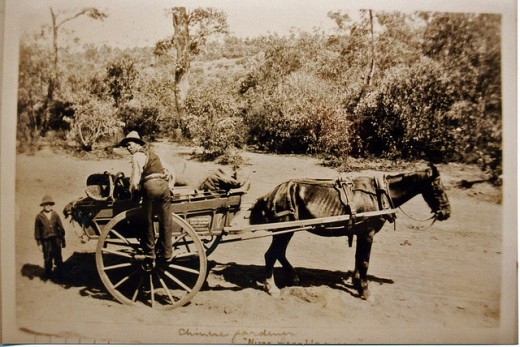 Jimmy War Sing, Chinese market gardener and fruiterer on his sulky in The Gully; the poor horse not well fed.
His ‘Chinese Garden’ was situated in a natural gully with a small watercourse running through it behind Loftus and Neale Streets (McRae’s Paddock).
(Photo circa 1903), supplied by Colin Slade in Pict. Memories Blue Mountains, John Low 2002)^http://www.flickr.com/photos/blue_mountains_library_-_local_studies/2669879647/ . Jimmy War Sing, Chinese market gardener and fruiterer on his sulky in The Gully; the poor horse not well fed.
His ‘Chinese Garden’ was situated in a natural gully with a small watercourse running through it behind Loftus and Neale Streets (McRae’s Paddock).
(Photo circa 1903), supplied by Colin Slade in Pict. Memories Blue Mountains, John Low 2002)^http://www.flickr.com/photos/blue_mountains_library_-_local_studies/2669879647/ .
Two particular historic events have adversely impacted upon The Gully’s ecological integrity and its human community. The first event was the bulldozing of the natural swamp of frogs hollow in the 1940s by developer Horace Gates to construct a dam as an artificial lake as part of his theme park scheme for the Gully. A few years later a Catalina flying boat was floated in the dam (lake) as a tourism draw card. At some time in the late 19th Century a local by the name of McRae, decided to bulldoze and infill the wetland in the mid part of the valley so that he could graze his horse stock.
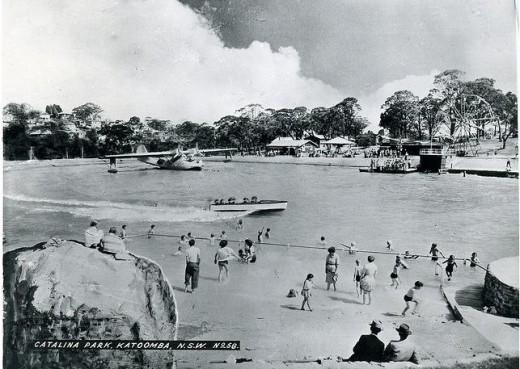
The second event was the bulldozing of the entire top valley including the homes of several families in 1957 by the Blue Mountains Council in collaboration with a local fraternity car racing drivers and local businessmen to make way for a motor racing circuit – ‘Catalina Raceway’. Those families were forcibly evicted from their homes, extricated from The Gully and one woman died of a heart attack during the raid.
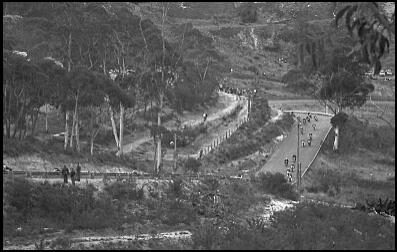
Catalina Raceway was used for motor racing through the 1960s, by the 1970s the racing circuit had steadily fallen into disrepair. This was due to a number of factors – repeated foggy weather at many racing events, the inability of the racing association to repay its construction debt to the Blue Mountains Council, new competition from circuits nearer to Sydney (Oran Park and Amaroo Park), and due to the prohibitive cost of increasing motor racing safety standards, prompted by the death of two racing drivers on separate occasions at ‘Craven A Corner’.
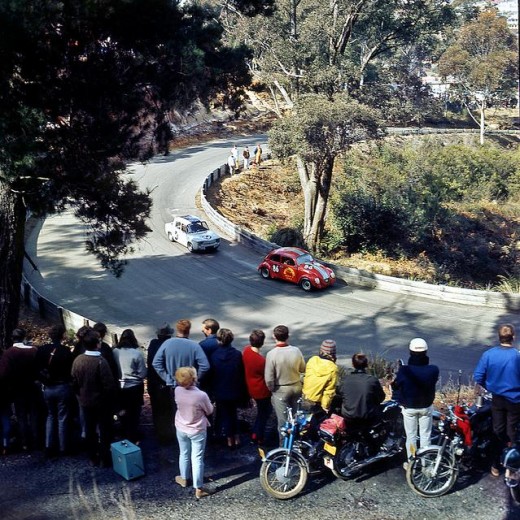
The track became overgrown and weeds spread throughout the valley. Blue Mountains Council named the valley ‘Catalina Park‘, and later named the top northern part of the valley as ‘Frank Walford Park’ after the namesake of a previous councillor who had been a key decision maker in approving the racetrack be built. Car racing at Catalina, culminating in the formation of the Blue Mountains Tourist Association.
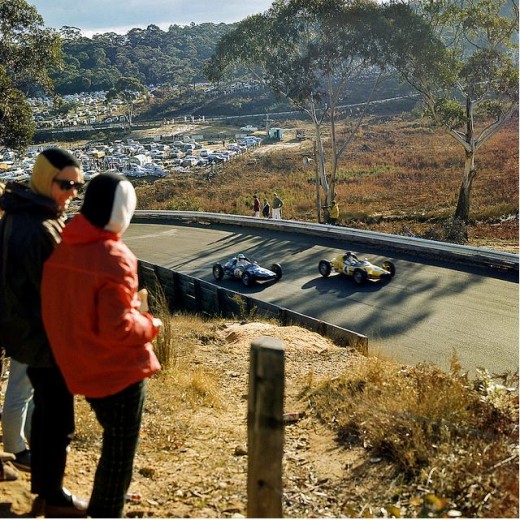
Catalina Raceway was a form of early Blue Mountains tourism and became very popular with car racing enthusiasts during the 1960s and 1970s.
In 1989, local nearby residents concerned about the poor state of the valley and with a desire to stop the car racing and protect the natural values of the valley, formed The Friends of Katoomba Falls Creek Valley, Inc. (‘The Friends’).
This grassroots local community group of local Katoomba residents established as one of the first bushcare groups in the Blue Mountains and since then their volunteers have regularly engaged in bush regeneration throughout the valley.
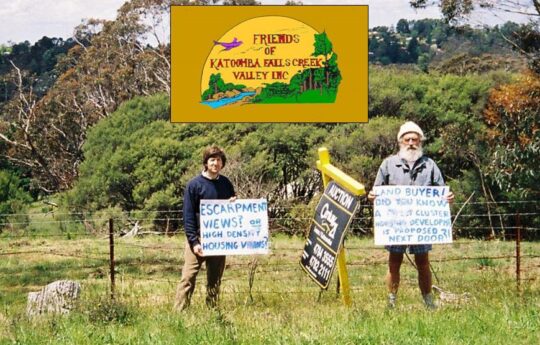 One of many protests by members of ‘The Friends’ (1989-2016) to save The Gully (‘the Valley’) from harm mainly from housing developers and tourism operators seeking to profiteer. In this photo locals Ivan Jeray and the late Neil Stuart (joint founder of The Friends) in 2005 protesting about the proposed massive deforestation and subdivision of this remnant side gully into a 69 lots of new houses dubbed 21 Stuarts Road Katoomba.
The Friends also galvanised local community support to stop the racing and to rehabilitate the valley back to its natural condition, holding street stalls to raise funds and to raise community awareness over the plight of the long neglected valley. The Friends lobbied Blue Mountains Council over nearly three decades to have the car racing banned, to have the weeds removed and to restore the valley to its pre-1957 natural state.
The Friends’ became instrumental in having plans prepared for the rehabilitation for the valley, most notably the 1993 Bell Report prepared by environmental consultant Fred Bell, the only one done so in consultation with the local community. To date, none of the several plans drafted has been put into effect by local council, so the Gully remains neglected and the race track long abandoned, yet the natural bush vegetation is steadily recovering.
In 2000, local Darug elder, Aunty Dawn Colless, was instrumental in achieving proper recognition for The Gully as an official Aboriginal Place under the New South Wales National Parks and Wildlife Act. On 18th May 2002, regrettably after Dawn’s passing, The Gully became protected under Sections 84, 85 and 90 from development and all racing formally banned.
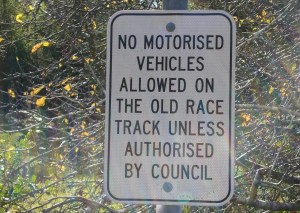
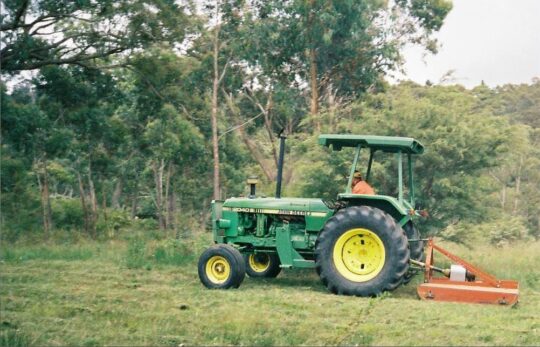 We dubbed this tractor towing a mower/slasher as ‘Hector’. It has been a notorious tool of destruction of the ecology of The Gully, also known for decades as Katoomba Falls Creek Valley.
Concerned local residents around The Gully back in 1988 began to realise that this natural creek valley immediately upstream and feeding Katoomba Falls and Kedumba River with fresh drinking water, was becoming increasingly under threat of destruction from various external vested interests. So in 1989 a mob of them formed a local community environmental conservation bushcare and activist group , The Friends of Katoomba Falls Creek Valley Inc.
This committed volunteer community group ran for some 27 years under the leadership and inspiration of local social worker and teacher, Neil Stuart. Most members of ‘The Friends’ initially lived within the water catchment of Katoomba Falls Creek Valley – a natural amphitheatre of multiple watercourses on the western side of the Blue Mountains township of Katoomba, which covered about 600 hectares.
So yes they were NIMBYS proudly, defending their beautiful natural place from selfish invaders threatening to ruin and exploit the Nature and its natural amenity.
Without the concerted efforts and activism of this committed community group, it is most likely that The Gully would now no longer exist, but be a valley of housing and recreational development.
The purpose of this webpage is to offer a perpetual factual account of the truth about The Gully, its recent history, its stories, its plethora of threats to undermine its integrity, values and spirit over many decades, and the stories of the ongoing abuse, neglect, battles, egos, bias – warts and all.
In 2004, the Blue Mountains {city} Council finally released it 2002 draft Plan of Management for The Gully, however, after seven years is yet to be funded and implemented; council preferring to fund multi-million urban developments such as nearby Katoomba Cultural (Shopping) Centre. In that same year, past Aboriginal residents and descendants of The Gully collaborated with local council management to have an archaeological survey conducted at key traditional cultural sites throughout The Gully.
In early 2006, a collaborative coalition of various community members including traditional Gundungurra and Darug and The Friends and formed ‘The Gully Guardians’, although this was short-lived due to undermining tactics by political interests within Blue Mountains Council causing hostilities. This was superseded by the establishment of the ‘Gully Traditional Owners’ in June 2006 by representatives of the Aboriginal people that had inhabited the Gully over many generations. The Gully Traditional Owners has since that time collaborated with Blue Mountains {city} Council to achieve New South Wales grant funding for restoration works, including a planned interpretative walking track through the Gully.
‘The Gully Cause’
The Gully Cause (i.e. saving it from ongoing abuse and neglect) is an humanitarian one as it is an ecological one.
This creek valley is the site of some of the Blue Mountains most divisive conservation battles that persist – citing the forced evictions by Council, the notorious 1957 bulldozing for a car racetrack, the bulldozing for Katoomba golf course, massive subdivision for housing, council profiteering from land sales for incremental housing development, deforestation for mass tourism, arson, a sports centre development by council, the creek diverted into a dam as part of one of two wacky theme park developments, etc, etc.
The values, history, stories, threats, abuse and neglect remain ongoing. The Habitat Advocate was established in 2006 as a conservation activist organisation based in The Gully water catchment situated in inner west Katoomba.
Since the events of 1957, when council acquired the majority of what was then known as Katoomba Falls Creek Valley upstream of Katoomba Falls to the highway, most of the land has been deemed Council Community Land, so it is largely public open space, except for the many sections sold off for development – both housing subdivision and mass tourism.
The editor of The Habitat Advocate has lived within The Gully water catchment since 2001 and has contributed an active community voluntary role to protect the natural values of The Gully and assist local residents and former residents of The Gully and their descendants in a constructive way. This includes years of Bushcare weeding, SCA Streamwatch drinking water quality monitoring winning five awards from the Sydney Catchment Authority, as well as community activism as a member of the former local Katoomba community group Friends of Katoomba Falls Creek Valley Inc. (affectionately termed ‘The Friends’ by its members), which spanned some 26 years (1989 – 2016) protecting and the defending this natural valley from all sort of development threats.
In addition, our editor was a member of the former Gully Guardians (a joint informal coalition of both local Aboriginal and non-Aboriginal locals and former residents of The Gully and their descendants). I have enjoyed ongoing co-operation with The Gully Traditional Owners.
The Habitat Advocate grew out of its editor’s five year membership of local Katoomba protest action group The Friends from 2002 to 2006. The Habitat Advocate is intimately aware of The Gully’s values, cultural sensitivities, histories, issues and threats that continue to affect this special place.
The Gully Collection
This Habitat Advocate webpage is dedicated to the conservation values of The Gully and remains a work-in-progress, collating various records, documents, images and accounts on The Gully so that locals, past, present and emerging of all persuasions may learn more about the important conservation values of this special place, thus continuing in the conservation spirit of The Friends.
We have amassed a considerable library of knowledge on The Gully spanning a century.
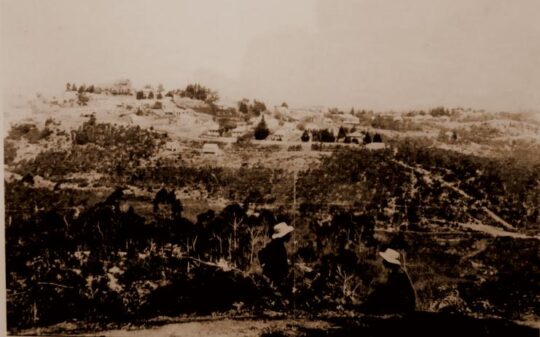 An early photo of The Gully’s landscape (circa. 1920), taken looking from from the rear of the Balmoral Guesthouse (then 196 Main Street, since renamed Bathurst Road) in Katoomba perhaps by the renowned Blue Mountains photographer Harry Phillips (1873-1944) An early photo of The Gully’s landscape (circa. 1920), taken looking from from the rear of the Balmoral Guesthouse (then 196 Main Street, since renamed Bathurst Road) in Katoomba perhaps by the renowned Blue Mountains photographer Harry Phillips (1873-1944)
The following hyperlinks below are to pages and posts internally on this website that over time will form a reference library of material on The Gully restricted to what is in the public interest – ‘The Gully Collection‘ (created by The Habitat Advocate from 2016):
Leave a Reply
You must be logged in to post a comment.
September 4th, 2011
Whilst touring Tasmania’s highland country in 2009, we stopped over in the old rural town of Bothwell.
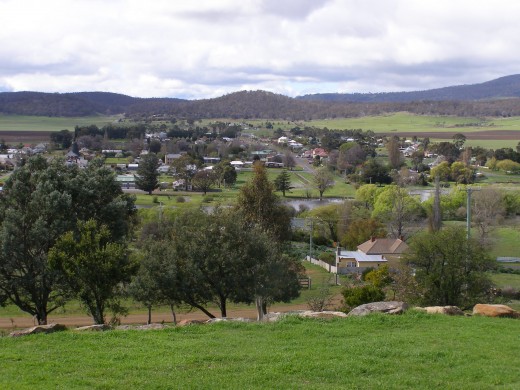 A pastoral Bothwell ~ an ode to the British countryside A pastoral Bothwell ~ an ode to the British countryside
looking from Barrack Hill over the River Clyde
(Photo by Editor 2009, free in Public Domain)
(click photo to enlarge, then again to enlarge again)
.
Bothwell is historically known for its colonial exploration dating back to 1806, its convict past dating back to the 1820’s, and for its soldiers’ barracks, and for its pastoral colonial heritage.
Its namesake was derived from a town in Lanarkshire, Scotland; likewise the naming of the River Clyde.
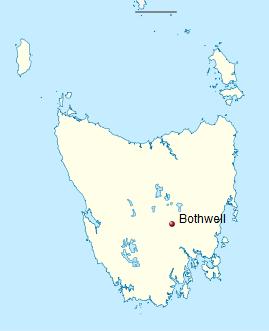 Bothwell
Situated in the Tasmanian South East Bioregion Bothwell
Situated in the Tasmanian South East Bioregion
.
Few will know of the prior Tasmanian Aboriginal heritage of the 5 bands of the traditional Tasmanian tribe (kinship group) the ‘Teen Toomle Mennenyer‘ of this highland and river region. Many were either massacred, rounded up and put into missions, or succumbed to European diseases. Most were dispersed from their traditional lands by 1832. This otherwise labelled ‘Big River Tribe‘ likely due to the big river country characterising this fertile inland region; rivers of which subsequently named the Derwent, Ouse, Clyde, Shannon, Weld, Styx, Plenty, Jordan, Lake, Isis and Pine, amongst others.
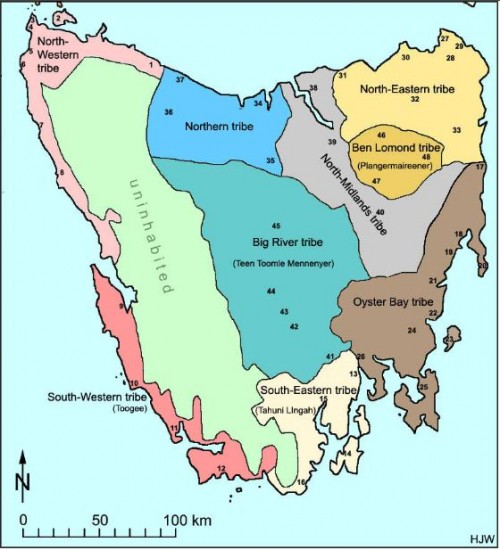 Traditional Aboriginal Territories of Tasmania Traditional Aboriginal Territories of Tasmania
.
Even fewer will know of the extensive tall Tasmanian Swamp Gum forest that for thousands for years blanketed this lush river valley, prior to it being clear-felled for timber and to make way for colonial pasture.
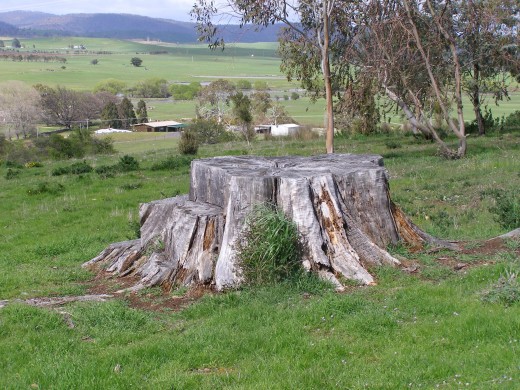 ‘Dead Heritage’
Stump of a Tasmanian Swamp Gum (Eucalyptus regnans)
on Barrack Hill, overlooking Bothwell
(Photo by Editor 2009, free in Public Domain
(click photo to enlarge, then again to enlarge again) ‘Dead Heritage’
Stump of a Tasmanian Swamp Gum (Eucalyptus regnans)
on Barrack Hill, overlooking Bothwell
(Photo by Editor 2009, free in Public Domain
(click photo to enlarge, then again to enlarge again)
.
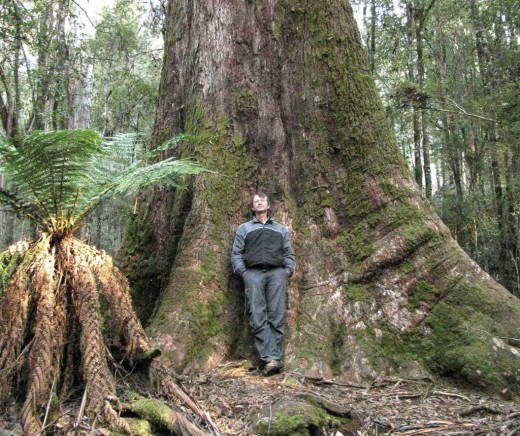 ‘Tasmanian Natural Heritage’
‘Tasmanian Natural Heritage’
Tasmanian Swamp Gum
The type of Swamp Gum forest around Bothwell
that would have greeted the colonists back in the 1820s
(© Photo Magi Nams)
Source: http://www.nams.ca/MagiBlog/tag/tasmanian-snow-gum/page/2/
.
.
Fifty kilometres down the road from Bothwell on the tourist drive, lies the old colonial town of Oatlands. The old Callington Flour Mill in the town has become a tourist attraction and has recently been restored aided by a $1.2 million grant by Australia’s Minister for Trade, Simon Crean, in 2007.
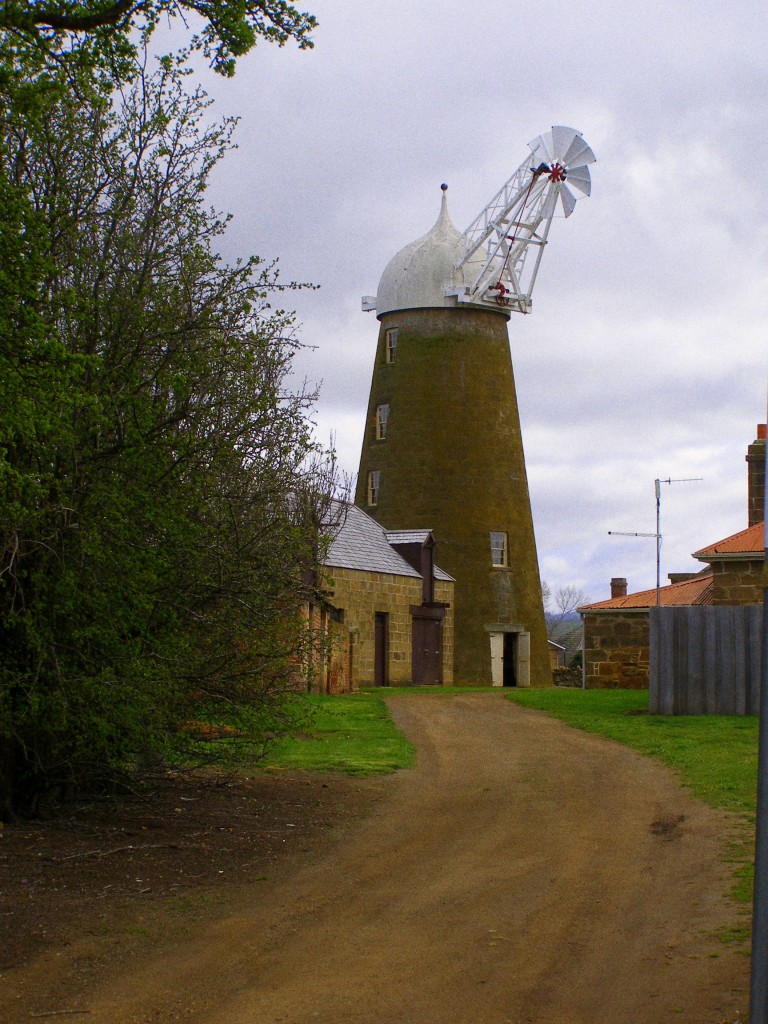 ‘Tasmanian Colonial Heritage’
Oatlands’ Wind Mill
The 1837 landmark Callington Flour Mill, recently restored
(Photo by editor, September 2009, free in Public Domain)
‘Tasmanian Colonial Heritage’
Oatlands’ Wind Mill
The 1837 landmark Callington Flour Mill, recently restored
(Photo by editor, September 2009, free in Public Domain)
.
Part of that restoration involved adding new structural posts in its interior. The following photo is of a rather new looking hardwood post inside the mill. It looks like local Messmate/Stringybark (Eucalyptus obliqua), generically marketed as ‘Tasmanian Oak‘.
.
Other local timbers sold as ‘Tasmanian Oak’ are Alpine Ash (Eucalyptus delegatensis) and Swamp Gum (Eucalyptus regnans).
On Mainland Australia, Eucalytus regnans is referred to as Mountain Ash ~ once the world’s tallest tree species, once taller than the Californian Redwood.
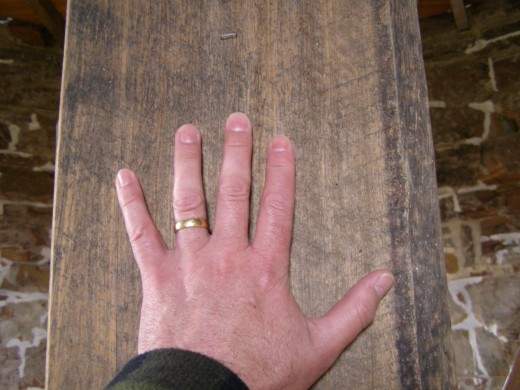 The environmental cost of Tasmanian Tourism
A new ten inch (wide) post inside Oatlands’ restored mill,
probably from local Messmate/Stringybark (Eucalyptus obliqua)
(Photo by editor, September 2009, free in Public Domain)
. The environmental cost of Tasmanian Tourism
A new ten inch (wide) post inside Oatlands’ restored mill,
probably from local Messmate/Stringybark (Eucalyptus obliqua)
(Photo by editor, September 2009, free in Public Domain)
.
.
.
.
.
Further Reading:
.
[1] ‘The Traditional Tasmanians‘, ^http://www.andaman.org/BOOK/chapter52/5-Tasmania-traditional/traditional.htm [Read More]
.
– end of article –
.
Tags: Big River Tribe, Bothwell, Dead Heritage, Eucalyptus globulus, forgotten forest, Oatlands' Callington flour mill, stump heritage, Tasmania, Tasmanian Aborigines, Tasmanian Blue Gum, Tasmanian Natural Heritage, Tasmanian South East Bioregion
Posted in Tasmania (AU), Threats from Deforestation, Threats from Tourism and Recreation, Threats to Wild Tasmania | No Comments »
Add this post to Del.icio.us - Digg
Leave a Reply
You must be logged in to post a comment.
September 3rd, 2011
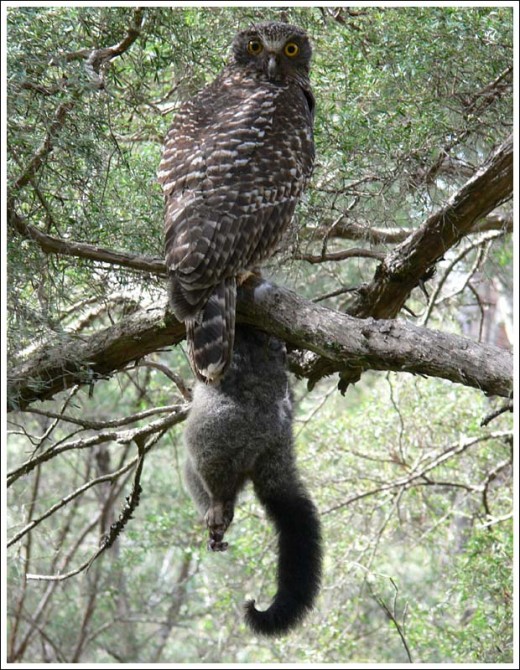 Australia’s native Powerful Owl with native prey – a juvenile Brushtail Possum (2kg?) Australia’s native Powerful Owl with native prey – a juvenile Brushtail Possum (2kg?)
© Photo by Duncan Fraser
^http://www.natureofgippsland.org/
.
Powerful Owl Call
(turn on your computer volume)

.
.
Drought, bushfires…it’ll take years to find out what’s happened to Victoria’s Forest Owls
.
[Source: ‘Something is knocking the states owls off their perches‘, by John Elder, The Age newspaper (Victoria, Australia), 20100613, ^http://www.theage.com.au/victoria/something-is-knocking-the-states-owls-off-their-perches-20100612-y4s0.html]
.
‘What’s happened to Victoria’s carnivorous owls? A significant number have vanished, and the (Victorian) Department of Sustainability and Environment (DSE) isn’t sure what’s going on.
It’s assumed the top end of the woodland food chain is either starving to death because its food source has been killed off by the drought and fires, or it is relocating to parts unknown, but it will take years to find an answer.
The DSE has been monitoring the owl populations – including that of the Powerful Owl, Australia’s largest owl – since 2000. Since then, detection rates in South Gippsland and the Bunyip State Park have dropped by half.
In some areas of the Bunyip State Park – half of which was lost to the Black Saturday fires – detections of the Sooty Owl have dropped to a third.
DSE owl specialist Ed McNabb says: ”We don’t know what’s happened to them. We can only assume that drought has played a major role. We noticed the downward trend before the fires. They’re very mobile birds, but the fires would have had an impact on their prey.”
Powerful and sooty owls, both officially listed as vulnerable, mainly eat sugar gliders and ringtail possums. The possums in particular are known to have little resistance to chronic hot weather, and their failure to thrive in the drought is the main reason why owl numbers have dropped.
While owls may have escaped (Victoria’s) Black Saturday fires, many possums would have been incinerated.
.
McNabb says the smaller carnivorous birds, such as the barking owl, are able to sustain themselves on insects. Powerful and sooty owls can also eat rabbits and birds such as magpies and kookaburras, but they need to make the change in their diet before energy loss reduces their ability to effectively hunt.
”They’ll either starve or take something else,” said McNabb.
Equally disastrous for the owls was the loss of old trees with large hollows that they require for nesting. They might have shifted elsewhere to recolonise, but this would mean taking over an already occupied territory. ”And there tends to be a home-ground advantage in these battles,” said Mr McNabb. The occupying bird has inside knowledge of the territory and a greater capacity to defend its patch, because it’s energy store will be higher. Flying great distances in search of food saps the strength from large birds and even causes them to starve.
The DSE’s biodiversity team leader for West Gippsland, Dr Rolf Willig, said:
The top order carnivores were ”an indicator species as to the well-being of the ecosystem.
Theoretically, if they’re happy, the rest are happy.”
.
For five years Dr Willig has been running a playback monitoring program in South Gippsland, where recordings of owl calls are played into the dark and answering calls are recorded. The number of birds answering calls have dropped significantly this year.
”The results indicate we may be having a delayed reaction from the fires,” he said. ”The possums not actually killed in the fires might have been exposed afterward, and the owls picked them off, eating all the food that was left.”
It will take years to find out what’s happened. ”And not just three or five years. We’ll be out here for a long time,” said Dr Willig.’
.
.
‘Conservation through Knowledge’ – a motto of leadership

The Royal Australasian Ornithologists Union is Australia’s largest non-government, non-profit, bird conservation organisation. It has sensibly branded itself as ‘Birds Australia‘, which in just two words says all that it is about, and the Emu family graphic is uniquely representative of Australia ~ the Emu being Australia’s largest bird.
Similarly sensible is its motto ‘Conservation through knowledge‘ which provides inspiration for conservation leadership, beyond Ornithology. The organisation was founded way back in 1901 to promote the study and conservation of the native bird species of Australia and adjacent regions, making it Australia’s oldest national birding association.
The Powerful Owl call above is sourced courtesy of Birds Australia.
.
.
Powerful Owl (Ninox strenua)
http://www.birdsaustralia.com.au/our-projects/powerful-owl-wbc.html
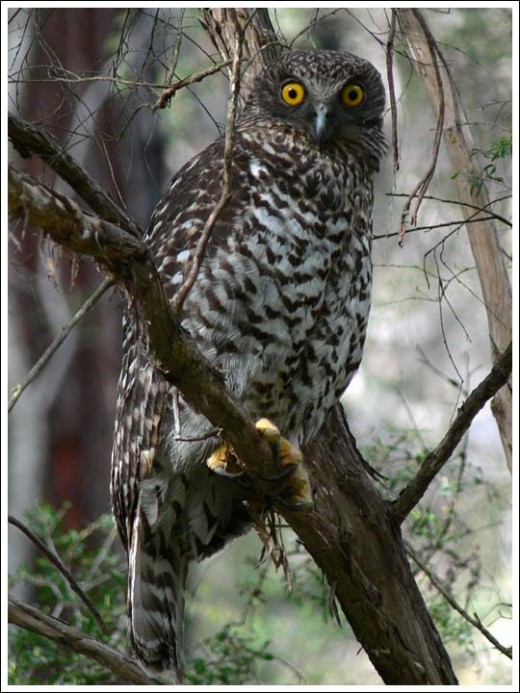 Powerful Owl (weighs under 1.5 kg) Powerful Owl (weighs under 1.5 kg)
© Photo by Duncan Fraser
^http://www.natureofgippsland.org/
.
A noctural top-order predator of tall old forests, the Powerful Owl is territorial, sedentary and monogamous ~ it calls one place home and mates for life (a lifestyle model for many humans).
.
HABITAT
Throughout most of its range this species typically inhabits open and tall wet sclerophyll forest, mainly in sheltered, densely vegetated gullies containing old-growth forest (where they breed in hollows in large trees) with a dense understorey, often near permanent streams. Such habitats are often dominated by Mountain Grey Gum, Mountain Ash, Manna Gum or Narrow-leafed Peppermint. They occasionally also occur in rainforest in gullies surrounded by sclerophyll forest or woodland. Powerful Owls also occur in adjacent open dry sclerophyll forests and woodlands, such as those dominated by box–ironbark eucalypts, Candlebark, Messmate or riparian River Red Gums; they sometimes also occur in open casuarina and cypress-pine forests.
The main food source for these owl species is hollow-dependant mammals (e.g. greater gliders, sugar gliders). Natural processes that create tree hollows typically take hundreds of years to form.
Human disturbed forests, through logging/burning/fragmentation/euphemistic ‘clearing’, destroy these vital yet rare hollow-bearing trees, and this considerably disadvantages owls.
DISTRIBUTION
- Endemic (found nowhere else on the planet, except for…) to eastern and south-eastern mainland Australia, mainly on the seaward side of the Great Divide.
.
CONSERVATION STATUS
- Vulnerable in Queensland
- Vulnerable in New South Wales
- Vulnerable in Victoria
- Endangered in South Australia
.
SURVIVAL THREATS
- Powerful Owls are adversely affected by the clearfelling of forests and the consequent conversion of those forests into open landscapes. [Deforestation]
.
When in flight, the silhouette of the Powerful Owl is distinctive, combining long, broad, rounded and deeply fingered wings with a large, sturdy body and a longish tail, gently rounded at the tip when spread. The flight is rather slow, with deep laboured wing-beats interspersed with glides.
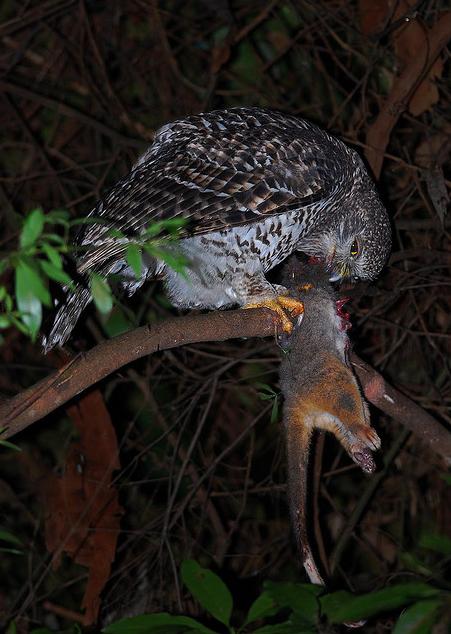
.
.
References and Further Reading:
.
[1] The Nature of Gippsland (photographic website), ‘A photo gallery featuring the natural world of Gippsland, Victoria, Australia’, Photographs by Duncan Fraser, ^ http://www.natureofgippsland.org/
[2] Birds Australia, (Special survey on Powerful Owl distribution around Sydney, 2011), ^ http://birdsinbackyards.net/surveys/powerful-owl.cfm
[3] ‘ Powerful Owl (Conservation) Action Statement, Victorian Government, Department of Sustainability and Environment, (1999), ^ http://www.dse.vic.gov.au/__data/assets/pdf_file/0019/103177/092_powerful_owl_1999.pdf [ Read More]
[4] ‘ Protecting Victoria’s Powerful Owls‘, Victorian Government, Department of Sustainability and Environment, (2001), ^ http://www.dse.vic.gov.au/__data/assets/pdf_file/0012/102144/PowerfulOwls.pdf [ Read More]
.
– end of article –
Tags: Birds Australia, Conservation through Knowledge, Forest Owls, hollow-bearing trees, old growth, Otway Ranges, Powerful Owl, Sooty Owl, South Gippsland
Posted in 07 Habitat Conservation!, Gippsland (AU), Otway Ranges (AU), Owls, Threats from Bushfire, Threats from Deforestation | No Comments »
Add this post to Del.icio.us - Digg
Leave a Reply
You must be logged in to post a comment.
September 2nd, 2011
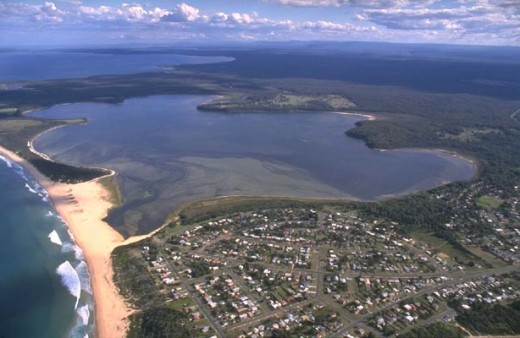 Lake Wollumboola,
South Coast (Shoalhaven Region) of New South Wales, Australia Lake Wollumboola,
South Coast (Shoalhaven Region) of New South Wales, Australia
.
Where is NSW Premier Barry O’Farrell’s environment minister when you need her?
.
Where is NSW Minister for Environment (etc.) Robyn Parker when it comes to a land use development threat to coastal breeding grounds of migratory birds and to a nominated Ramsar Wetland?
Lake Wollumboola is a natural shallow, saline, coastal lagoon, located on the NSW south coast lies north juxtaposed to Jervis Bay and forms an integral part of the Jervis Bay National Park. Lake Wollumboola is listed as a wetland of national importance, and the NSW Office of Environment and Heritage is investigating its nomination as a wetland of international importance under the Ramsar Convention on Wetlands.
Lake Wollumboola supports abundant growth of sea grass and algae, and is currently home to several thousand black swans and grey and chestnut teals and ten threatened species of Australian fauna. International migratory birds depend upon Lake Wollumboola during seasonal migration including the Caspian Tern and Little Tern.
 Little Tern (Sterna albifrons) with its distinctive black crest
[Source: ^http://www.ozanimals.com/Bird/Little-Tern/Sterna/albifrons.html] Little Tern (Sterna albifrons) with its distinctive black crest
[Source: ^http://www.ozanimals.com/Bird/Little-Tern/Sterna/albifrons.html]
.
NSW Minister for Environment etc Robyn Parker may have come to politics with the credo of ‘keeping it real’, but what environmental conservation credibility does Robyn Parker have? Many conservations are trying to keep Lake Wollumboola real and indeed free from a new golf course development threat on its northern shores.
Parker’s claim to fame is in teaching, community services, child care, childhood education, early intervention, and health issues such as drug rehabilitation and education. But sorry Adrian Piccoli MP got the Ministry for Education. So why did O’Farrell gift her with the important and controversial ‘Environment’ portfolio? No-one else put their hand up? What personal interest does Robyn Parker have in Environmental Conservation? NSW Environment Minister Robyn Parker has probably never heard of Lake Wollumboola. Has she?
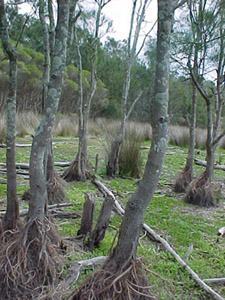
.
.
.
20th Century Golf Course Development Threat to Lake Wollumboola
.
According to the Sydney Morning Herald 20110827, defenders of Wollumboola are worried about a proposal for an 18-hole golf course on the lake’s north-western shore lodged with Shoalhaven City Council by the developer Allen, Price and Associates on behalf of the landowner, Warren Halloran. Halloran is bleating the standard ‘jobs, jobs, jobs‘ and ‘good for tourism‘ justifications for his planned development. But seriously it is just about profiting from exploitative development of natural land without a care to the ecological impact. The development concept is backward 20th Century, who the hell plays golf in the 21st Century? Golf clubs are in crisis around the nation trying to find new members. Their existing membership base of baby boomers are dying of old age!
A development application for the course lodged with the council on June 30 has attracted more than 60 submissions, nearly three-quarters opposed. Review of the proposal by local Shoalhaven Council is likely taking place behind closed doors as a ‘Confidential Business Paper‘ ~ which translates into ‘democracy exempt‘.
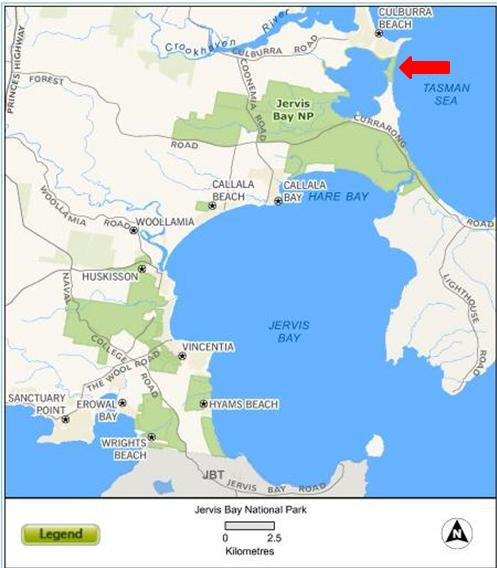
.
Council Decision on RAMSAR Wetlands?
.
The president of the Lake Wollumboola Protection Association, Frances Bray, said one of the biggest dangers from a golf course would be increased runoff of organic material and fertilisers.
It is feared that algal blooms could choke the lake, killing the fish, crustaceans and seagrass that can attract up to 20,000 birds during drought.
”It’s just the most beautiful serene place and to think that that could be degraded for a golf course is an absolute tragedy,” Ms Bray said.
A water management plan submitted with the development application proposed the construction of wetlands to treat stormwater runoff from the site, but the plan acknowledged that not all of the fairway areas would be covered.
The Greens councillor Amanda Findley, said the proposal was a last-minute attempt to develop land set down to become conservation land under proposed new land zoning.
But the proposed golf course has garnered some support from nearby Culburra Beach for employment opportunities and increased tourism.
The council will hold a public meeting on Monday.’
.
[Source: ‘Water hazard: golf plans at prized lake ruffle conservationists’ feathers’, Peter Rae, 20110827, Illawarra Mercury,^http://www.illawarramercury.com.au/news/national/national/environment/water-hazard-golf-plans-at-prized-lake-ruffle-conservationists-feathers/2272184.aspx, accessed 20110828]
 Jervis Bay Heathland near Lake Wollumboola
(© Photo by Michael Thompson) Jervis Bay Heathland near Lake Wollumboola
(© Photo by Michael Thompson)
.
.
Lake Wollumboola?
.
The Shoalhaven landscape is home to some of the outstanding natural features of the South Coast of NSW. The landscape contains wetlands of national importance, significant habitat for international migratory species, and is a habitat stronghold for the threatened Green and Golden Bell Frog.
The scenic beauty of the lower Shoalhaven and the lifestyle of coastal and estuary villages attract large numbers of visitors to the area. Important Aboriginal places around the estuary, coastal floodplain and headlands reflect a cultural attachment to the estuary’s natural resources extending over thousands of years. The Shoalhaven region includes a number of sensitive natural assets. The Shoalhaven River and estuary system, Jervis Bay, Coomondary Swamp and Lake Wollumboola and a number of other coastal lakes and estuaries all represent sensitive natural environments.
.
Lake Wollumboola
Lake Wollumboola and is a coastal estuarine lake within the Shoalhaven region situated south of Culburra Beach, between the Shoalhaven River and Jervis Bay and the Beecroft Peninsula. The Lake, sand bar and south west part of the catchment are included in the Jervis Bay National Park. It has an area catchment of 35 km2, and a waterway area of 6.2 km2. Lake Wollumboola is situated between Culburra Beach (north) and Currarong Road (south) at the northern end of the Beecroft Peninsula. Coonemia Creek flows into Lake Wollumboola. This estuary falls in the area covered by Southern Rivers Catchment Management Authority.
The lake does not possess an inlet channel – after periods of sufficient rainfall, the lake breaches directly across Warrain Beach to form the entrance.
Lake Wollumboola is recognised for its conservation attributes, and in 2002 was included in the Jervis Bay National Park. The Lake is frequented by thousands of native black swans, ducks, herons and waders, especially as a wetland refuge in times of drought. Large numbers of migratory birds visit the lake including over twenty species protected by international treaties.
‘Protected (endangered) species such as the Little Tern and Green and Golden Bell frog breed on the foreshores of the lake.’
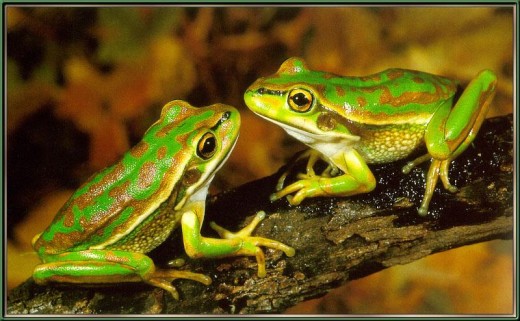
Endangered Green and Gold Bell Frogs (Litoria aurea)
.
Lake Wollumboola possesses over a square kilometre of seagrass meadows, which provide vital habitat and food sources for the many migratory bird species that seasonally visit the lake. The endangered species Wilsonia rotundifolia is also present.
The woodlands, white sands and translucent waters of Jervis Bay are reminiscent of an early, pristine environment. This park has many facets – woodland and heath, wetland and lake, seagrass beds, bays and beaches. Together they create a place that is especially beautiful. The unique Lake Wollumboola is an integral part of the park with the lake, its foreshores, associated wetlands, creeks and springs interlocking to produce twelve rich waterbird habitats in a relatively small area.
Aboriginal heritage goes back many thousands of years here and local Aboriginal people continue to maintain strong links with places special to them.
Shoalhaven City Council formed the Lake Wollumboola Estuary Management Task Force to prepare the Lake Wollumboola Estuary Management Plan.
With gazetting of the lake as part of the Jervis Bay National Park the Lake Wollumboola Reference Group was established by Department of Environment and Conservation (DEC) to oversee preparation of the Lake Wollumboola component of the Jervis Bay National Park Plan of Management.. The NSW Government is preparing a Sustainability Assessment for Lake Wollumboola, as recommended by the Healthy Rivers Commission Inquiry into Coastal Lakes.
But high human population growth rates in the Shoalhaven places considerable pressure on these natural resources, highlighting the need for appropriate management and investment.
.
Wetlands Under Threat
.
‘Wetlands are among the most threatened ecosystems in the world.
In the past, many wetlands were drained or filled in to create farmland or urban areas. In NSW, regional wetland losses range from 40% to 80% since European settlement. Although no longer openly destroyed, wetlands are currently affected by alteration of natural flow patterns caused either by droughts or by water extraction and regulation of rivers by building dams and weirs. Urban development, land clearing, grazing and use of pesticides can also impact adversely on water quality and the natural water cycles of wetlands.
Another threat to wetlands, and other ecosystems, is climate change. In inland NSW, climate change is expected to modify rainfall, evaporation and flooding patterns, increase droughts and bushfires, change the temperature of water bodies and, along the coast, cause sea levels to rise. This threat will cause the coastline to retreat and saltwater to flood freshwater lakes and lagoons.’
.
[Sources: ^ http://www.environment.nsw.gov.au/nationalparks/parkhome.aspx?id=N0090,
NSW Department of Natural Resources, ^http://test.dnr.nsw.gov.au/estuaries/inventory/wollumboola.shtml
Southern Rivers Catchment Management Authority, ^http://www.southern.cma.nsw.gov.au/our_catchment-shoalhaven.php
NSW Government Land and Property Information , Atlas of NSW – Wetlands, ^http://www.atlas.nsw.gov.au/public/nsw/home/topic/article/wetlands.html]
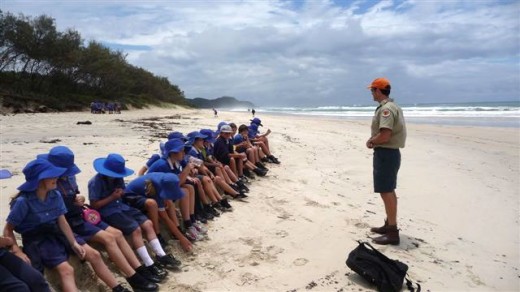
.
.
‘International recognition due to Lake Wollumboola on World Wetlands Day’
.
[Source: Nature Conservation Coucnil of NSW, 20080201, ^http://www.nccnsw.org.au/media/international-recognition-due-lake-wollumboola-world-wetlands-day]
.
The state’s peak environment group has called for the protection of Lake Wollumboola near Culburra Beach on the eve of World Wetlands Day on Saturday 2nd February.
“The Nature Conservation Council calls on the NSW Government to celebrate the unique beauty of Lake Wollumboola this World Wetlands Day and protect it under a Ramsar listing,” Cate Faehrmann, executive director of the Nature Conservation Council said today.
“Lake Wollumboola more than meets the criteria to be protected by an international Ramsar listing.
“Lake Wollumboola is a fragile and unique place that provides a safe haven for many endangered plants and animals like the Little Tern and the Green and Golden Bell Frog.
“Of the nine possible criteria for being protected under the international Ramsar listing, Lake Wollumboola meets five. Only one of these conditions needs to be met to make the area eligible for protection.
“A Ramsar listing for the lake would allow low impact recreational activities to continue, and encourage international nature and Aboriginal cultural heritage tourism and environmental education activities.
“Lake Wollumboola is one of the largest shallow saltwater lake in New South Wales. It often provides a home for thousands of iconic water birds and waders like Swans, Chestnut Teal and Bar tailed Godwits.
“The lake supports at least 43 species of migratory birds large populations of local species, with bird populations estimated at over 20,000,” Ms Faehrmann said.
.
.
During 2001/2 Researchers have been studying the complex processes of Lake Wollumboola, including the presence of Hydrogen Sulfide in the sediments and water column, and the age and rate of deposition of the sediments.
Shoalhaven City Council through its Lake Wollumboola Estuary Management Task Force developed a Community Education strategy for Culburra Beach. This focuses primarily on the Hydrogen Sulfide issue. The National Parks and Wildlife Service is likely to proceed with this program.
.
[Source: http://www.wollumboola.org.au/]
.
.
‘Lake Wollumboola gazetted as part of the Jervis Bay National Park’
.[Source: http://www.wollumboola.org.au/news.php]
.
On 11th December (1997), the Attorney General and Minister for the Environment, Mr. Bob Debus announced his decision to gazette the bed of Lake Wollumboola, the sand bar and surrounding crown land as part of the Jervis Bay National Park. Mr. Debus said the lake is one of the most significant water habitats in the State. “in recent years we have been fortunate to witness an extraordinary natural phenomena on Lake Wollumboola when 20,000 waterbirds at a time gather to feed on the lake’s rich food source.”.
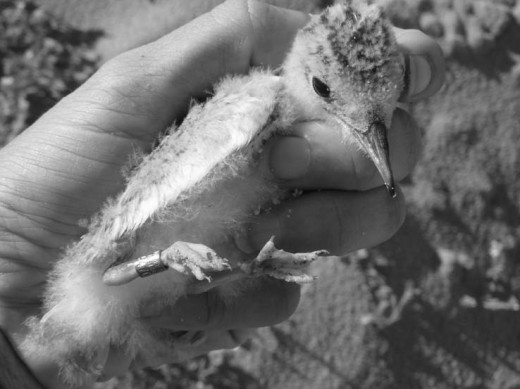 Little Tern chicks at Lake Wollumboola, 2008
(click photo to enlarge) Little Tern chicks at Lake Wollumboola, 2008
(click photo to enlarge)
.
.
.
‘The saviours of Lake Wollumboola’
[Source: Penny Figgis (ACF Vice President and a board member of the Environment Protection Authority of NSW) and Bruce Donald (Sydney lawyer and consultant, and gave voluntary legal advice to the campaign).
© 2000 Australian Conservation Foundation, © 2008 Gale, Cengage Learning, ^http://findarticles.com/p/articles/mi_hb4727/is_4_28/ai_n28789147/
.
In 2008, local conservationists, Frances Bray and Keith Campbell, were celebrated as winners of the Australian Conservation Foundation’s Peter Rawlinson Conservation Award.
‘For more than seven years Frances and Keith, together with many dedicated people in the Lake Wollumboola Support Group, tirelessly fought against a huge subdivision of some 3000 houses that would have unquestionably damaged the unique ecology of the lake and its surrounding forest.
Lake Wollumboola is one of the New South Wales coastline’s last remaining, virtually pristine, coastal lakes that intermittently open and close to the sea. It lies at Culburra Beach between the mouth of the Shoalhaven River and Jervis Bay. The lake is on the Register of the National Estate, is a wetland of key significance and a habitat for resident and migratory birds of international importance. Several threatened species have been identified within the area, including the green and gold bell frog which is seasonally abundant in the grassy edges of the lake.
For most of the past century the land around the lake was within the paper subdivision plans of the only major developer of the Shoalhaven, Realty Realizations. In the early 1990s the company finally achieved a rezoning of the land by the Shoalhaven City Council and the government of the day. The subdivision carried with it the threat of serious pollution from urban run-off, loss of forested habitat and increased recreational pressures, including demands to prevent the lake’s natural cycle of periodic draining.’
.
In for the long haul
‘Although the politics and regional power dynamics were against them and government departments were equivocating, Frances Bray and Keith Campbell refused to consider the battle lost. Together with the Lake Wollumboola Support Group, they mobilised all the effort needed to begin the task. Their dogged campaign finally achieved a decision in 1995 by the Minister for Urban Affairs and Planning to remove from the council its ability to approve the subdivision. Then, in 1996, a Commission of Inquiry into the subdivision was appointed.
At this point Frances and Keith enlisted some voluntary legal back-up and achieved a historic grant of legal aid for the inquiry from the New South Wales Legal Aid Commission. Though small, this grant helped obtain high calibre water, fauna, vegetation and social impact reports from acknowledged experts to give independent substance to their case. This also contributed to a reversal by National Parks and Wildlife Service on the first day of the inquiry of its previous decision that a Faunal Impact Statement was not necessary. Gradually over the extended four years of the inquiry the support of the principal regulatory agencies gathered force.
All of this, however, was achieved against strident support for the development at the local level. Local media targeted Frances, Keith and their colleagues with all the familiar distressing and defamatory charges that make this sort of campaign emotionally exhausting for those in the front line. These attacks continued over the duration of the inquiry and, with the enormous demands of preparing submissions of a high quality and responding to the voluminous information advanced by the developer, lesser campaigners would have been knocked out of the race. Yet they completed an outstanding and detailed submission, now held by the Environmental Defenders Office (NSW) as the leading precedent for pro-environment representation.’
.
Inspiration for us all
‘The tireless and exhausting efforts by these two remarkable campaigners and their colleagues was rewarded when on 5 April 2000 the Commission of Inquiry ruled for the environment and against the development, adopting nearly all of Frances and Keith’s submissions.
Then on Friday 2 June, just a few days before ACF announced its award, Deputy Premier and Planning Minister, Dr Andrew Refshauge, announced the government’s decision to refuse the proposed residential subdivision within the catchment of the lake.
The ACF Peter Rawlinson Conservation Award presents a fitting opportunity for a more public recognition of these brave and passionate people who were not prepared to stand and watch the loss of a place of such enormous value. They are fitting winners of the environment movement’s highest accolade.’
.
‘Turning Point for Lake Wollumboola’
[Source: Frances Bray, (2000), NPA supporter and Convenor of the Lake Wollumboola Support Group, ^http://dazed.org/npa/npj/200012/Deccover.htm]
.
This has been an extraordinary year for coastal protection generally, and for Lake Wollumboola in particular. The Premier, the Hon Bob Carr, outlined new policy directions. The NSW Government announced in April that the catchments of five South Coast lakes would be protected as national parks. It then requested the Healthy Rivers Commission to conduct an inquiry into the protection and management of coastal lakes. The Coastal Lakes Inquiry issues paper brought further good news, with its proposals for Lake Wollumboola and eight other South Coast lakes to be protected as reserves and considered for World Heritage listing.
Then on 2nd June the Deputy Premier and Minister for Urban Affairs and Planning, Dr Andrew Refshauge, announced his decision to refuse the Long Bow Point subdivision application, at Culburra Beach near Nowra on the South Coast. The proposal involved development of 837 housing lots, stage 1 of a 3,000 lot development, mainly in the catchment of Lake Wollumboola (see also June NPJ). He said,
“The evidence is overwhelming – our primary concern must be the long-term protection of the Lake.”
Members of the Lake Wollumboola Support Group are overjoyed by the Minister’s adoption of our case. The group has been campaigning, since 1993, to stop the development because of its likely destructive impacts on the unique ecology of this most fragile of coastal lakes and its catchment.
Our group was formed in response to Shoalhaven City Council seeking comment at the commencement of the Estuary Management Study for Lake Wollumboola. Soon after, we learned of plans by Realty Realisations, a landowner and developer, for a massive development primarily in the catchment of the lake. We decided to work to protect the lake, and to inform the Culburra Beach community on related issues.
.
A unique ecology
Lake Wollumboola is located just north of Jervis Bay. Maps and records from 1805, when the first Europeans came to the area, confirm that Lake Wollumboola was much the same then as it is today and that the area provided a rich environment for Aboriginal people. The Jerringa people maintain today their traditional cultural ties with Lake Wollumboola and the Beecroft Peninsula.
Lake Wollumboola is an intermittently closing and opening lake. It is particularly vulnerable to urban pollution and disturbance because it is shallow, above mean sea level and is infrequently open to the sea, causing high nutrient levels to build up in the sediments. Additional pollution is likely to maintain permanently eutrophic conditions, with algal blooms, death of seagrass and ultimately decline of the lake’s extraordinarily rich ecology.
Inter-glacial wave-cut reefs and rock platforms form much of the lake bed. The lake’s catchment is coastal bushland, wetland and heath of significant biodiversity, with at least 300 species each of flora and fauna at Long Bow Point, and at least 33 threatened species in the immediate catchment. Green and golden bell frogs are reasonably abundant around its shore, as well as the extremely rare wetland plant Wilsonia rotundifolia.
The lake is listed on the Register of the National Estate, in the Directory of Wetlands of national significance, and meets the criteria for listing under the Ramsar Convention as a wetland of international significance for water birds.
Lake Wollumboola is recognised and protected under migratory bird agreements with China and Japan as internationally significant habitat. At least 43 species of migratory birds, including little terns, have been identified, as well as large populations of local species such as black swan, teal and royal spoonbill. In the summer of 1999 a spectacular bird event occurred, with populations in excess of 20,000 and high bird populations are continuing.
.
Long-standing conflict
Conflict between protection of the natural environment of the Jervis Bay region and inappropriate development is long-standing. Since the early 1900s, Realty Realisations (the principal landowner in the region) has floated various plans to develop paper subdivisions in environmentally sensitive areas. There is equally a long history of efforts to protect this unique area. Myles Dunphy in the 1940s and NPA in 1974 put forward proposals to Government to protect the lake and the Beecroft Peninsula to its south.
The NPA case for national park status, as quoted by Alan Catford in the National Parks Journal, August 1974, says, “The club-shaped Beecroft Peninsula, which backs Point Perpendicular, the northern part of Jervis Bay, combined with the magnificent lagoon of Lake Wollumboola and the connecting lowland, is an ideal national park. Variety is surely its keynote.”
Realty Realisations and Shoalhaven City Council had other ideas. In 1992 the north-west area of the catchment was rezoned to residential as the Culburra Urban Expansion Area, by agreement between Realty Realisations, the Council and the NSW Government.
In 1995, Shoalhaven City Council was poised to approve the Long Bow Point Subdivision application, despite our protests and the reservations of several government agencies. Following the election of the Labor Government, the then Minister for Urban Affairs and Planning, Craig Knowles, in August 1995 called in the Long Bow Point subdivision and subsequently agreed to establish a Commission of Inquiry (COI).
In October 1996, Commissioner Carleton convened the first session of the Long Bow Point Subdivision COI. The Lake Wollumboola Support Group, the Culburra Beach Progress Association and, finally, the government agencies, opposed the subdivision. The NPWS reversed its previous position and advised that a Fauna Impact Statement (FIS) would be required. At the resumption of the Inquiry in November 1996, the Commissioner adjourned it indefinitely at the request of the developer, to allow for completion of a FIS.
The following three years of waiting were very stressful. In March 1998 we suffered a major setback with the release of the NPWS’ Assessment of the Natural Heritage Values of the Culburra Urban Expansion Area and Environs. While this report recommended consideration of national park or marine park status for Lake Wollumboola and recognised the high conservation values of much of the proposed development site, it recommended to the Minister for the Environment that the Government not purchase Long Bow Point. The Minister, Pam Allen, accepted this recommendation, to our great disappointment. Nevertheless, the Government purchased a large area of land between Jervis Bay and the southern shore of the lake, which is now part of Jervis Bay NP.
In November 1999, the COI reconvened, with the final hearing in January this year. In April, the COI report was released, recommending refusal of the subdivision because of its likely impact on Lake Wollumboola and its catchment. On 2 June, Dr Refshauge announced his decision to refuse the subdivision and to establish a review of planning controls and environmental management for the catchment.
.
Techniques for success
The success of our part in this landmark decision was due to several factors.
We studied and recorded the behaviour of Lake Wollumboola, analysed and interpreted research and expert advice. With the assistance of a Legal Aid Commission grant, we obtained advice from a highly professional group of experts who supported us in our submissions and presentations. Their original data and research covered water quality; evaluation of water-pollution control measures; ecology of the lake and its catchment, particularly its extraordinary birdlife; environmental law; and social and economic impacts of the proposed development.
We also worked closely with environment groups who gave us expert and strategic support, in particular Total Environment Centre, NPA, Nature Conservation Council, the Australian Conservation Foundation (ACF) and our local coalition of environment and community groups, the Jervis Bay Regional Alliance.
On World Environment Day, a few days after Minister Refshauge’s announcement, ACF recognised our efforts by awarding Frances Bray and Keith Campbell the Peter Rawlinson Conservation Award. This prestigious award focuses national attention on the lake and will assist us greatly in our ongoing campaign: to have Lake Wollumboola and its catchment protected from urban development for all time.
We are delighted also that the Lake Wollumboola Support Group has received local recognition. Narelle Wright, Frances Bray and Keith Campbell were honoured with Shoalhaven Healthy Cities awards, for their efforts to protect the lake.
Whilst the refusal of the Long Bow Point subdivision provides breathing space, the future of protection of Lake Wollumboola is not yet guaranteed. We hope this year represents the turning point, with the Healthy Rivers Commission Coastal Lakes Inquiry issues paper adding further weight to the Lake Wollumboola cause.
We hope other local environment groups will take heart from our success so far and join us in supporting these significant proposals.
.
References
-
- The Hon Bob Carr. Speech to the Brisbane Institute, A Matter of National Importance – Protection of the Australian Coastline. April 2000
- Healthy Rivers Commission. Independent Inquiry into Coastal Lakes – Issues Paper. October 2000
- Ministerial media release, 2 June 2000
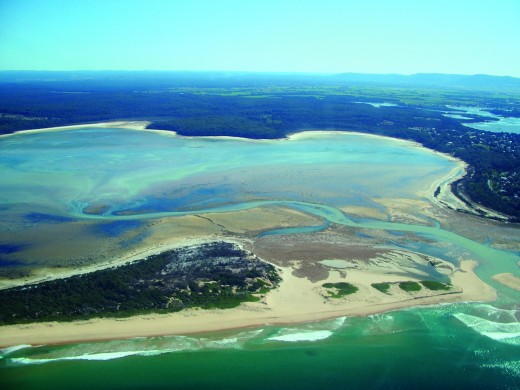 Lake Wollumboola – nominated RAMSAR wetland
(click photo to enlarge, then click to enlarge again!) Lake Wollumboola – nominated RAMSAR wetland
(click photo to enlarge, then click to enlarge again!)
.
.
History of Estuary and Catchment Use and Abuse
.
[Source: ‘Coastal Management in Australia – Key institutional and governance issues for coastal natural resource management and planning‘, (2006), published by the CRC for Coastal Zone, Estuary and Waterway Management, and supported by The Australian National University and the National Sea Change Taskforce, ^http://www.griffith.edu.au/__data/assets/pdf_file/0006/313359/Coastal_Management_in_Australia.pdf [Read More]
.
‘Critical to human health and the biological health of coastal waterways are factors influencing the discharge of waters, sediments, nutrients and pathogens into rivers and estuaries.
Throughout the 19th and 20th centuries, land clearance, soil erosion and urbanisation (including canal estates) have all contributed to the cumulative degradation of rivers, estuaries and coastal lakes.
Symptoms of the degradation are many including:
- Siltation of channels, which in some cases like on the Hunter has resulted in downstream displacement of shipping ports, and in the burial of estuarine sea grasses;
- Increased levels of nutrients, especially nitrogen and phosphorus, which are key elements for plankton and plant growth and trigger algal blooms when they reach excessive levels; and
- The presence of pathogens which may be digested by humans causing death and ill-health following consumption of seafood, or ingested while swimming.
.
Quite clearly urbanisation and deforestation has had some effect along the east coast.
The saga of Wallis Lake since the oyster contamination event of 1997 is there to remind us of the sensitivities of waters to pollutants. These sensitivities are not just biophysical and economic, but also lead to complex judicial proceedings on responsibilities under the common law concept of ‘duty of care’ as determined in the Wallis Lake case by the High Court.
We know that increasing nutrient loads or even the sediment loads from catchments into estuarine and lake systems may not trigger much change as these systems have considerable resilience to varying biophysical conditions. However, the fear is always that a lake/lagoon or estuary backwater will go beyond the ‘critical load point’. Turbidity and phytoplankton will then dominate.
It was such a concern that encouraged the then Planning Minister for NSW, Andrew Refshauge, in 2001, to stop a 2000-lot subdivision at Lake Wollumboola on the NSW south coast. This was at a location which years before had been zoned for such intensive urban use.’
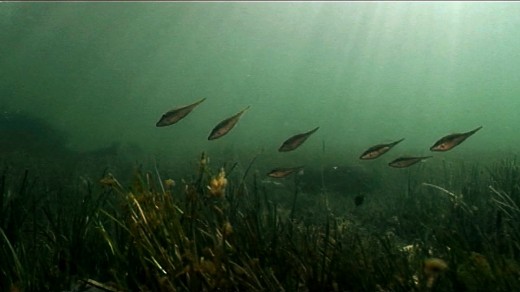
Seagrass Meadow
Source: ^http://www.hn.cma.nsw.gov.au/
..
‘Lake Wollumboola- Listing as a Ramsar site’
[Source: Amanda Findley, Shoalhaven Greens blogsite, 20110628, ^http://amandashoalhavengreens.blogspot.com/2011/06/lake-wollumboola-listing-as-ramsar-site.html]
 Black Swans and Teal (left) on Lake Wollumboola
© Photo by Frances Bray
(click photo to enlarge, then click to enlarge again! ~ you’re being looked at.) Black Swans and Teal (left) on Lake Wollumboola
© Photo by Frances Bray
(click photo to enlarge, then click to enlarge again! ~ you’re being looked at.)
.
.
‘Shoalhaven Council is it so narrow minded that it will not support taking a step forward in listing a lovely wetland in the RAMSAR register? seems so.
Department of Environment and Heritage have approached Council to advise that they wish to begin the process of talking to the community about listing this special little lake as a significant wetland- local campaigner Frances Bray sent the following letter to Council to try and influence tonights decision making.
Thanks Frances for allowing me to share this and your great photo of the swans and teals.’
~ Amanda Findley.
————————–
‘To General Manager and Shoalhaven City Councillors,
Please circulate this message to all Councillors,
I understand that at your meeting on Tuesday next, that you will consider a recommendation to oppose the listing of Lake Wollumboola as a Wetland of International importance under the Ramsar Convention.
Today I have been on a bird counting walk at Lake Wollumboola with ornithologist, Ms Joy Pegler. The Lake is an astonishing site, with Joy counting 1100 Black Swan, 957 Grey Teal and 536 Chestnut Teal, as well as 9 other species.
Here is a photo of some of the birds which are easily viewed from the north shore. Do come and enjoy this wonderful experience.
I urge you to think carefully about the benefits of Ramsar listing. Increased monitoring and research into this unique Lake would benefit its management, whilst maintaining current recreational activities. There would be significant benefits for the Aboriginal community from employment in management and Cultural tourism opportunities if community members choose to support Ramsar listing. The local and wider Shoalhaven community would benefit too from carefully promoted and managed national as well as international tourism.
The Lake Wollumboola Protection Association Inc as well as many Culburra Beach residents and ratepayers strongly support Ramsar listing, knowing the special qualities of the Lake especially for birds and understanding that Lake Wollumboola meets the relevant Ramsar criteria.
We understand that the NSW Office of Environment and Heritage is in the process of consulting the Aboriginal community regarding its views and we respect the need for that consultation to continue before the Office proceeds with consultation with the wider community.
Please do not jeopardise the planned consultations and the opportunities represented by Ramsar listing.’
Yours faithfully,
Frances Bray.
President Lake Wollumboola Protection Association Inc
.
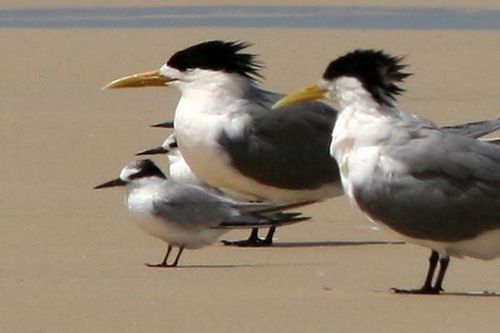 Little Terns Little Terns
.
.
Footnote
.
Ramsar Convention on Wetlands
.
The Convention on Wetlands of International Importance, called the Ramsar Convention, is an intergovernmental treaty that provides the framework for national action and international cooperation for the conservation and wise use of wetlands and their resources. The Ramsar Convention is the only global environmental treaty that deals with a particular ecosystem. The treaty was adopted in the Iranian city of Ramsar in 1971 and the Convention’s member countries cover all geographic regions of the planet.
The Convention on Wetlands is an intergovernmental treaty whose mission is “the conservation and wise use of all wetlands through local, regional and national actions and international cooperation, as a contribution towards achieving sustainable development throughout the world”. As of October 2010, 160 nations have joined the Convention as Contracting Parties, and more than 1900 wetlands around the world, covering over 186 million hectares, have been designated for inclusion in the Ramsar List of Wetlands of International Importance.’
The Ramsar Mission
‘The Convention’s mission is “the conservation and wise use of all wetlands through local and national actions and international cooperation, as a contribution towards achieving sustainable development throughout the world”.
The Convention uses a broad definition of the types of wetlands covered in its mission, including lakes and rivers, swamps and marshes, wet grasslands and peatlands, oases, estuaries, deltas and tidal flats, near-shore marine areas, mangroves and coral reefs, and human-made sites such as fish ponds, rice paddies, reservoirs, and salt pans.’
.
What are wetlands?
.
‘As defined by the Convention, wetlands include a wide variety of habitats such as marshes, peatlands, floodplains, rivers and lakes, and coastal areas such as saltmarshes, mangroves, and seagrass beds, but also coral reefs and other marine areas no deeper than six metres at low tide, as well as human-made wetlands such as waste-water treatment ponds and reservoirs.’
The Wise Use Concept
.
‘At the centre of the Ramsar philosophy is the “wise use” concept. The wise use of wetlands is defined as “the maintenance of their ecological character, achieved through the implementation of ecosystem approaches, within the context of sustainable development”. “Wise use” therefore has at its heart the conservation and sustainable use of wetlands and their resources, for the benefit of humankind*.’
.
[Source: ^http://www.ramsar.org]
.
*Editor: “for the benefit of humankind‘? Why so anthropocentric? It is not as if humankind has not benefited itself since it could at the expense of other species.
A more appropriate ending phrase would be:… “out of respect for the ecological rights of wetland-dependent species and ecological communities for survival, health and natural life processes, undisturbed”.
.
Further Reading:
.
[1] Lake Wollumboola Protection Association Inc. ^ http://www.wollumboola.org.au/
[2] ‘ Management of Amphibian Populations in Booderee National Park, South-Eastern Australia‘ (2010), by Trent D. Penman (University of Wollongong) and Traecey Brassil (NSW Department of Primary Industries) [ Read More]
[3] ‘Giving Little Terns Their Best Chance of Survival – Lake Wollumboola Little Tern Conservation Program’, (2008), by Frances Bray, ^ http://www.coastalconference.com/2008/papers2008/Bray,%20Frances%20Session%205A.pdf
[4] ‘ South Coast Shorebird Recovery Programme (2008/09 Breeding Season)’, ^ http://www.southcoastshorebirds.com.au/shorebird_downloads/annual_report/Shorebird%20Report%20200809final.pdf
[5] ‘Illawarra Bird Observers Club, Inc.’, ^ http://www.iboc.org.au/info/IBOCNewsMay2010.pdf
[6] R.J. Williams, G. West, D. Morrison and R.G. Creese, (2006), ‘ Estuarine Resources of New South Wales’, prepared for the Comprehensive Coastal Assessment (DoP) by the NSW Department of Primary Industries, Port Stephens.
[7] R.J. West, C.A. Thorogood, T.R. Walford and R.J. Williams. (1985), ‘ An Estuarine Inventory for New South Wales, Australia‘, Fisheries Bulletin 2. Department of Agriculture, New South Wales.
[8] ‘Wise Use of Wetlands‘ (Handbook 1), RAMSAR Convention on Wetlands,^ http://www.ramsar.org/pdf/lib/hbk4-01.pdf [ Read More]
.
– end of article –
Estuary and catchment use and abuse
Critical to human health and the biological health of coastal waterways are factors
influencing the discharge of waters, sediments, nutrients and pathogens into rivers and
estuaries. Throughout the 19th and 20th centuries, land clearance, soil erosion and
urbanisation (including canal estates) have all contributed to the cumulative
degradation of rivers, estuaries and coastal lakes. Symptoms of the degradation are
many including:
• siltation of channels, which in some cases like on the Hunter has resulted in
downstream displacement of shipping ports, and in the burial of estuarine sea
grasses;
• increased levels of nutrients, especially nitrogen and phosphorus, which are key
elements for plankton and plant growth and trigger algal blooms when they reach
excessive levels; and
• the presence of pathogens which may be digested by humans causing death and
ill-health following consumption of seafood, or ingested while swimming.
Quite clearly urbanisation and deforestation has had some effect along the east coast.
The saga of Wallis Lake since the oyster contamination event of 1997 is there to
remind us of the sensitivities of waters to pollutants. These sensitivities are not just
biophysical and economic, but also lead to complex judicial proceedings on
responsibilities under the common law concept of ‘duty of care’ as determined in the
Wallis Lake case by the High Court.
We know that increasing nutrient loads or even the sediment loads from catchments
into estuarine and lake systems may not trigger much change as these systems have
considerable resilience to varying biophysical conditions. However, the fear is always
that a lake/lagoon or estuary backwater will go beyond the ‘critical load point’. Turbidity
and phytoplankton will then dominate. It was such a concern that encouraged the then
Planning Minister for NSW, Andrew Refshauge, in 2001, to stop a 2000-lot subdivision
at Lake Wollumboola on the NSW south coast. This was at a location which years
before had been zoned for such intensive urban use.
Tags: Allen Price and Associates, Beecroft Peninsula, Birds (Migratory), Caspian Tern, Culburra Beach, golf course development, Jervis Bay National Park, keeping it real, Lake Wollumboola, Lake Wollumboola Protection Association, Little Tern, Ramsar Convention on Wetlands, Ramsar Wetlands, Shoalhaven, Shoalhaven Council, Southern Rivers Catchment Management Authority
Posted in 07 Habitat Conservation!, Birds (Migratory), Threats from Development | No Comments »
Add this post to Del.icio.us - Digg
Leave a Reply
You must be logged in to post a comment.
August 29th, 2011
[The following article was initially published by Tigerquoll on CandoBetter.net on 20090730 under title ‘African Elephants – still slaughtered for tusk (‘ivory’) trinkets by backward Japanese and Chinese‘, with some modifications]
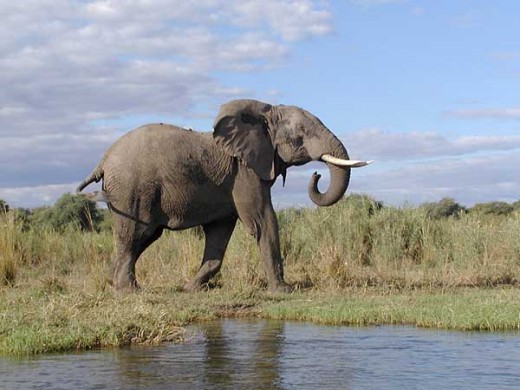 The magnificent African Bush Elephant bull (male) walking tall in its native savannah homeland
The magnificent African Bush Elephant bull (male) walking tall in its native savannah homeland
.
Out of Victorian colonial exploits of the 19th Century, elephant tusks could be found butchered and refined into expensive goods, notably billiard balls, piano keys, Scottish bagpipes, garment buttons, letter openers and for many ornamental items otherwise considered mere ‘trinkets’.
After the elephant tusk (‘ivory’) trade had decimated the African Elephant population from 1.3 million to 625,000, finally in 1989 the Environmental Investigation Agency (EIA) imposed a ban on this international elephant tusk (ivory) trade.
Ten years on, Zimbabwean dictator, Robert Mugabe, lifted the ban along with Botswana, Namibia, and South Africa and legalised the sale of elephant tusks from elephants they claimed (a) had died naturally or (b) been shot because they were violently aggressive or for ‘problem-animal’ control. In 1999, the Convention on International Trade in Endangered Species of Wild Fauna and Flora (CITES) authorized an auction of 50 tons of elephant tusks (ivory) from these four countries to the value of USD$5 million. Notably, the demand for elephant has been driven outside the African continent, in this episode mainly by Japan.
One could find a comparable solution for controlling Robert Mugabe…
 Tool of the Willing
(for just one day hire, …’our troubles there would be over very quickly’.)
~ borrowed from Colonel Walter E. Kurtz. Tool of the Willing
(for just one day hire, …’our troubles there would be over very quickly’.)
~ borrowed from Colonel Walter E. Kurtz.
.
In 2008, China was also given permission to become a licensed buyer of elephant tusks (ivory) and this followed 108 tons of elephant tusks (ivory) being auctioned from these same four African countries, representing the death of over 10,000 African elephants.
.
“The growing demand for elephant tusks (ivory) has increased black market prices from $200 per kilo to $850 per kilo in the past four years thus creating a big financial incentive for poachers. Michael Wamithi, program director for International Fund for Animal Welfare’s global elephants program, and former director of the Kenya Wildlife Service, declared: “An estimated 20,000 elephants are slaughtered annually for the trade in their tusks. Many African elephant range states clearly do not have the capacity or resources to combat these massive attacks on their countries’ wildlife heritage and the burgeoning markets in China are only fuelling these attacks.”
.
The Environmental Investigation Agency (EIA), which exposes environmental crimes, said CITES had ignored appeals from other African nations not to increase pressures on their elephant populations which were already struggling with wars, instability, droughts and poverty. EIA chairman Allan Thornton said:
“Responsibility for the poaching of 20,000 elephants in Africa each year will now lie with those who supported China obtaining legal ivory trade even though they continue to be the world’s biggest destination for poached ivory.”
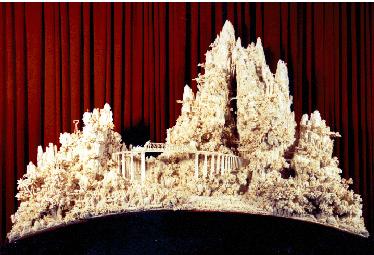 This elephant tusk (ivory) carving (photo) is a gift from China presented to the United Nations in 1974.
It depicts the Chengtu-Kunming railway, which was opened to traffic in 1970.
The sculpture was carved from eight elephant tusks. In elephant terms, four mature bull elephants were killed for this elaborate trinket. This elephant tusk (ivory) carving (photo) is a gift from China presented to the United Nations in 1974.
It depicts the Chengtu-Kunming railway, which was opened to traffic in 1970.
The sculpture was carved from eight elephant tusks. In elephant terms, four mature bull elephants were killed for this elaborate trinket.
One wonders whether the United Nations is still pleased with its eight bull elephant tusk trophy (shot and hacked off from a bull elephant like that above)?
.
.
Chinese, Japanese and Thais still Elephant Poaching in Africa
.
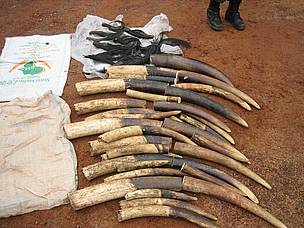
China and Japan bought 108 tonnes of ivory in another “one-off” sale in November 2008 from Botswana, South Africa, Namibia and Zimbabwe. At the time the idea was that these legal ivory sales may depress the price, thereby removing poaching pressure, an idea supported by both Traffic and WWF.
China’s increased involvement in infrastructure projects in Africa and the purchase of natural resources has alarmed many conservationists who fear the extraction of wildlife body parts is increasing. Since China was given “approved buyer” status by CITES, the smuggling of ivory seems to have increased alarmingly. Although, WWF and Traffic who supported the China sale, describe the increase in illegal ivory trade a possible “coincidence” others are less cautious. Chinese nationals working in Africa have been caught smuggling ivory in many African countries, with at least ten arrested at Kenyan airports in 2009. In many African countries domestic markets have grown, providing easy access to ivory, although the Asian ivory syndicates are most destructive buying and shipping tonnes at a time.
Contrary to the advice of CITES that prices may be depressed, and those that supported the sale of stockpiles in 2008, the price of ivory in China has greatly increased. Some believe this may be due to deliberate price fixing by those who bought the stockpile, echoing the warnings from the Japan Wildlife Conservation Society on price-fixing after sales to Japan in 1997, and monopoly given to traders who bought stockpiles from Burundi and Singapore in the 1980s. It may also be due to the exploding number of Chinese able to purchase luxury goods.
Despite arguments prevailing on the ivory trade for the last thirty years through CITES, there is one fact that virtually all informed parties now agree upon: poaching of African elephants is now seriously on the increase.’
.
.
‘Shopping habits of China’s ‘suddenly wealthy’
[Source: by Rose Gamble, freelance journalist, FT.com, 20090821, ^http://www.ft.com/cms/s/2/9271a266-8d21-11de-a540-00144feabdc0.html#ixzz1WPkaKde6, accessed 20110829]
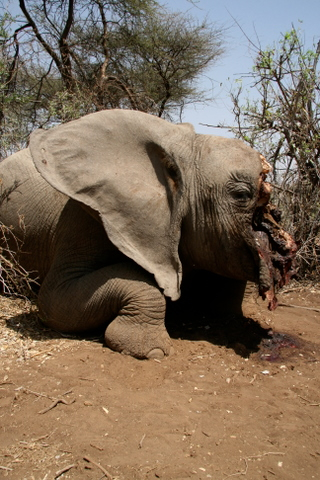
.
Ivory:
‘For more than 7,000 years, Chinese artisans have been crafting elephant ivory. Favoured by the Imperial household as far back as the Qing dynasty (1680), ivory has an illustrious reputation and an association with the wealthy and elite. But in 1989, the trading of ivory was banned worldwide through the Convention on International Trade in Endangered Species (Cites), after more than half of Africa’s 1.3 million elephants were poached in a single decade. And yet, with a carving trade established in antiquity and a burgeoning middle class who, for the first time, can afford to buy ivory, China remains its biggest importer.
As Asian elephant herds dwindle, African elephants have become the only source of ivory.
In late 2008, Cites authorities allowed China to bid with Japan for tusks from official stockpiles – consisting of ivory collected from elephants that had died a natural death – in four southern African countries. In an open declaration of a continuing demand, 12 Chinese traders bought 62 tonnes at an average price of $144 per kilo. Since this legal purchase, more than 11 tonnes of illegal African ivory have been impounded en route to China.
Elephant poaching largely takes place in central Africa, where poverty and political instability are rife. Chronic unemployment, the availability of firearms and corruption all facilitate the illegal ivory trade. These regions are also home to unregulated domestic ivory markets, where carved items are bought and sold. According to ivory expert Esmond Martin, the majority of buyers are Chinese. In a scramble for Africa’s minerals and resources, the continent has seen a recent influx of Chinese workers – a presence that is visibly reflected in the illegal retailing of ivory. On a recent trip to Addis Ababa, Ethiopia, Martin recorded 1,433 items of ivory openly displayed in the city’s main streets and central market. Among these were 149 pairs of freshly carved ivory chopsticks, selling for $16 each – in sharp contrast to a Chinese retail price of $139 – and signature stamps and jewellery. All of these items were small enough to potentially smuggle through customs.
Martin had previously estimated that 4,900 to 12,000 elephants from central Africa were killed each year to supply tusks to the craftsmen of Africa, China and Thailand.
Conservationists are deeply concerned. According to Barbara Maas, CEO of Care for the Wild International: “With the number of Chinese nationals resident in Africa rising, and poaching on the increase, the frontline between supply and demand for ivory is now perilously close, with a disastrous outcome for elephants.”
.
..
‘Campaigners’ fear for elephants, and their own credibility’
[Source: The Economist, 20080717, ^http://www.economist.com/node/11751304 ]
.
‘Nobody can deny that China’s black market was rampant until recently. In a report to the UN leaked by the Environmental Investigation Agency (EIA), a campaigning group, this month, Chinese officials admitted that between 1991 and 2002 they had lost sight of 121 tonnes of ivory, the equivalent of the tusks from 11,000 elephants.
Is China observing the CITES rules now? A brief visit to China in 2007 by inspectors from the CITES secretariat suggested that things had improved: they said that ivory was becoming harder to find, though they came across a shop in the city of Xi’an with ivory carvings of dubious provenance. A bigger investigation was carried out by TRAFFIC, an independent British-based group that monitors wildlife trade. After studying 10,000 shops between 2006 and 2008, it reported a progressive decline in the availability of illegal ivory. This had coincided with greater police vigilance.
The idea that China is cleaning up its act got another boost in March, when over 750kg (1,650lb) of raw ivory was seized in Guangxi Province. As CITES notes, the penalties for illegal trading include life imprisonment and death. But the EIA, which uses undercover methods to probe the trade, says things are not as good as they seem; in 2007 its researchers found a roomful of illegal ivory, including an uncut tusk, for sale in the city of Dalian. Last month they made a small find in Gansu province.
A more interesting question is how the legal sales now in prospect will affect the black market. A fresh supply of legal ivory may depress the price, and reduce the incentive to poach. TRAFFIC notes that after a legal auction in 1999, the price fell; this led to a decline in poaching over five years. For doctrinaire types, who oppose all trade in ivory, the forthcoming sale is not just a challenge to endangered animals; it could be a threat to the credibility of their best-loved arguments.’
.
.
‘Data shows illegal ivory trade on rise’
[Source: World Wildlife Fund (WWF), Cambridge, UK, 20091116, ^http://wwf.panda.org/wwf_news/?uNewsID=180702, accessed 20110829]

.
‘The illicit trade in ivory, which has been increasing in volume since 2004, moved sharply upward in 2009, according to the latest analysis of seizure data in the Elephant Trade Information System (ETIS).
ETIS, one of the two monitoring systems for elephants under CITES (the Convention on International Trade in Endangered Species of Wild Fauna and Flora) but managed by TRAFFIC, holds the world’s largest collection of elephant product seizure records.
The analysis, undertaken in advance of the 15th meeting of the Conference of the Parties (CoP15) to CITES, was based upon 14,364 elephant product seizure records from 85 countries or territories since 1989, nearly 2,000 more records than the previous analysis, in 2007.
The remarkable surge in 2009 reflects a series of large-scale ivory seizure events that suggest increased involvement of organized crime syndicates in the trade, connecting African source countries with Asian end-use markets. The ETIS data indicate that such syndicates have become stronger and more active over the last decade.
There continues to be a highly significant correlation between large-scale domestic ivory markets in Asia and Africa and poor law enforcement, suggesting that illicit ivory trade flows typically follow a path to destinations where law enforcement is weak and markets function with little regulatory impediment.
Indeed, the rise in illicit trade in ivory indicates that implementation of a CITES “action plan for the control of trade in African elephant ivory,” the Convention’s principal vehicle for closing such unregulated and illicit domestic markets in Africa and Asia, has failed to drive any significant change over the last five years.
The ETIS analysis identifies Nigeria, the Democratic Republic of the Congo and Thailand as the three countries most heavily implicated in the global illicit ivory trade. Illegal trade involving each of these nations has been repeatedly singled out for priority attention since the first assessment in 2002, but they continue to feature as critical hotspots in the trade as sources, entrêpots and consumers of ivory.
Another nine countries and territories—Cameroon, Gabon and Mozambique in Africa and Hong Kong SAR, Malaysia, the Philippines, Singapore, Taiwan and Vietnam in Asia—were also identified as important nodes in the illicit ivory trade.
China, which along with Japan was an approved destination of the legal, CITES-sanctioned one-off ivory sale in 2008, faces a persistent illegal trade challenge from Chinese nationals now based in Africa. Ongoing evidence highlights widespread involvement of overseas Chinese in the illicit procurement of ivory, a problem that needs to be addressed through an aggressive outreach and awareness initiative directed at Chinese communities living abroad.
The results are less clear-cut concerning the impacts of the CITES approved one-off ivory sales in 1999 and 2008.
Following the first such sale, in June 1999, there was a progressive decline in the illicit trade in ivory for five years, with no evidence to suggest that the sale had resulted in an increase in the illicit ivory trade globally.
After the second CITES-approved ivory sale, in late 2008, the results are unclear as to whether it has stimulated increase demand or whether it has simply coincided with an increase in supply that was already underway over the last four years. The collection of more data over an extended time period will throw further light on this vital issue.’
.
The full ETIS report can be downloaded from the CITES website as document at ^http://www.cites.org/common/cop/15/doc/E15-44-01A.pdf
[Read More]
.
.
‘China Fuels East African Elephant Poaching’
[Source: Damian Robin, Epoch Times, 20100330, ^http://www.theepochtimes.com/n2/content/view/32389/, accessed 20110829]
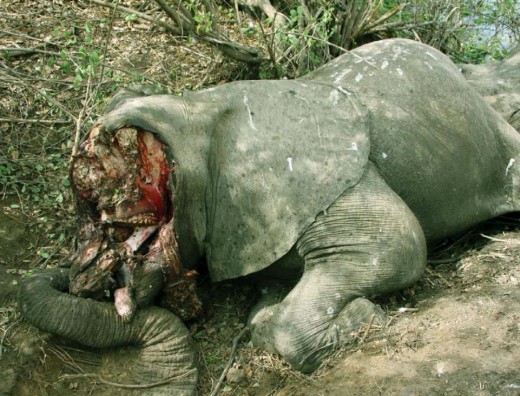
.
China’s influence in East Africa is fueling an upsurge in elephant poaching, gunrunning, and corruption according to a report on U.K. television Friday. A Channel 4 reporter spoke to people in villages and cities, wildlife managers, rangers, government officials, and illegal ivory sellers in Kenya and Tanzania—all of whom said China is the main buyer of banned ivory.
Filmed secretly, sellers told the journalist from Unreported World that during a presidential visit from Chinese Communist Party leader Hu Jintao in 2009, two hundred kilos of ivory was bought by Chinese diplomats and taken out of Tanzania.
The sellers did not say if Hu knew of the trade, but did say that a prominent diplomat from the Chinese Embassy frequently bought large amounts of ivory from them.
Kooky Gorman owns a wildlife park in Kenya. Accompanied by armed rangers, she took the reporter to many spots in her park, where elephant carcasses rotted, their heads split open to make it easy to saw the tusks off.
Many hides showed multiple bullet holes. The lead ranger said the killers had used AK47 automatic weapons to spray herds. The shootings were indiscriminate, killing young and old.
Gorman said the weapons were bought from neighboring Somalia where the civil war has continued since 1991.
The intensity of the poaching has been increasing for the past two years. In 2007 six elephants were poached from her park. In 2008, twenty-eight were poached. Fifty-seven were poached in 2009.
She says there is a threat of elephant extinction.
The Kenya Wildlife Service has strong rooms full of tusks and carved ivory taken during raids and confiscated at Nairobi airport. It has about 65 tons to 70 tons estimated at $10 million.
The U.N. recently rejected Zambia and Tanzania’s request to hold a one-off sale for their ivory stockpile, valued of approximately $15 million.
Since trade in ivory was stopped in 1989, some countries have been allowed to do a small amount of business in ivory if they have good conservation measures. Zambia and Tanzania are currently prohibited from any trade in ivory. The International Trade of Endangered Species of Fauna and Flora (CITES) annual meeting in Doha disregarded arguments that the sale could help police wildlife parks and stop the burden of protecting the horde of ivory.
Selous Game Reserve in Tanzania has 40,000 elephants.
On the TV program, a police informant who lived nearby in a village known for its illegal ivory deals said armed groups of 30 often came from Dara Salam in Senegal to take back ivory in 440-to-660-pound batches. (An average tusk weighs about 4.4 pounds.)
The informant, whose face was not shown for fear of reprisals, had had his house burned down recently.
Another man, who did not want to be identified as he had received death threats, was a safari operator who brings tourists to the Selous Reserve. “I think the wildlife department knows exactly what’s going on here,” he said. “There are some members of the games department who are poaching to supplement their pay and feed their families.”
He said he thinks movers are coming from China and the Far East to take bones and that they are in collusion with local authorities.
He said they could not get through the 15 to 20 policed roadblocks without help from “some very well-placed people.”
One illegal dealer said he had friends in airport security. “It’s no problem with money,” he told the reporter. “If you have money, it’s easy.”
There is a small industry carving the poached ivory for the East Asian trade. “Many people from China come and buy,” he said. There is a market for trinkets, seals, and chopsticks.
Chinese regime officials told Unreported World that they are against the illegal ivory trade and that Chinese diplomats did not illegally purchase or export ivory by misusing diplomatic immunity in 2009.
Most villagers have stood by while violence around the poaching continues. They felt threatened and were unable to prevent the elephant deaths. Now, many see tourism as the main way they can earn a living, so they are protecting the animals and habitat as much as they can.’

.
.
‘Ivory Stockpile Sale Rejected by U.N.’
[Source: Peter Valk, The Epoch Times, 20100324, ^http://www.theepochtimes.com/n2/content/view/31944/, accessed 20110829]
.
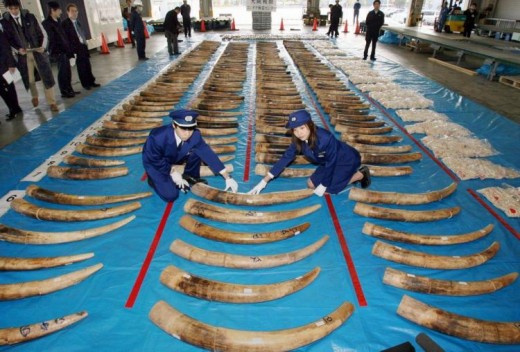 Custom officers display a total of 2.8 tons of ivory on March 1, 2007, a record amount seized in Japan, a top black market destination for elephant tusks.
The U.N.’s Convention on the International Trade of Endangered Species of Fauna and Flora rejected Zambia and Tanzania’s request to sell it’s stockpile of ivory.
(AFP/Getty Images)
. Custom officers display a total of 2.8 tons of ivory on March 1, 2007, a record amount seized in Japan, a top black market destination for elephant tusks.
The U.N.’s Convention on the International Trade of Endangered Species of Fauna and Flora rejected Zambia and Tanzania’s request to sell it’s stockpile of ivory.
(AFP/Getty Images)
.
‘Zambia and Tanzania’s request to hold a one-off sale for their ivory stockpile, valued of approximately $15 million, were rejected during the U.N.’s Convention on the International Trade of Endangered Species of Fauna and Flora (CITES) annual meeting in Doha. The increase of poaching and illegal ivory sales in both countries in 2009 were the main reasons for the rejection.
Since the ivory trade was banned in 1989, there has been an exemption that allows countries that have proven effective in conservation measures to have a small amount of regulated trade in ivory. Currently, Zambia and Tanzania are forbidden to sell ivory.
“It’s crucial that central and western African nations suppress the brazen poaching, mainly fueled by organized crime and illegal ivory markets openly operating within their borders before any further ivory sales take place,” said Sybille Klenzendorf, managing director of Species Conservation at WWF-U.S. in a press release.
According to a report from the Elephant Trade Information System (ETIS), which keeps track of ivory seizures, there exists a direct relationship between an increase in poaching and poor law enforcement. In the past two years, the number of elephants that were killed as a result of poaching has quadrupled.
Opponents of the ban say that Tanzania ought be allowed to dispose of their ivory stockpile as to avoid spending large sums of money on security and storage.
During the meeting, in which 175 countries participated, some animals were added to the list of protected species. The rise of e-commerce is now believed to be one of the latest and biggest threats to wildlife, as global Internet access has made it increasingly easy to buy and sell illegal wildlife products with little control.
“The transactions kind of come and go and take place before anybody really even knows it, leaving it to the post office to be enforcing this global regime of trade regulation,” Paul Todd, a campaign manager for the International Fund for Animal Welfare (FAW) was reported as saying by ABC news in Australia.
Back in 2005, a FAW investigation reported that in one week alone, over 9,000 live animals or products in five categories of animals were for sale on English-language Web sites, chat rooms and the popular auction site eBay. Some of the live animals found included a gorilla in London, and a Siberian tiger in the U.S. Body parts and products were also commonly found with ivory being common.’
.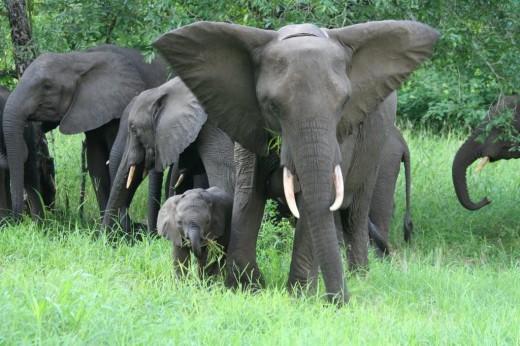
An African Elephant herd
(click photo to enlarge)
Elephants are very intelligent, lifelong loyal and have immense family bonds.
A female elephant listens and watches the photographer intently, with her young close to her side.
An elephant mother will protect her calf to her death.
.
.
 Australia’s big ‘game hunter’, Robert Borsak in Zimbabwe (2008)
Australia’s big ‘game hunter’, Robert Borsak in Zimbabwe (2008)
.

‘Macdonald’s game council thrill killer‘
by Andrew Clennell, State Political Editor, Sydney Morning Herald, 20090721, ^http://www.smh.com.au/environment/conservation/macdonalds-game-council-thrill-killer-20090720-dqui.html]
.
Robert Borsak (on the NSW Government’s Game Council) went to northern Zimbabwe to hunt elephants. On a two-week trip he killed several, including a bull elephant he shot in the head from a distance of six paces.”My reflexes took over as the rifle fired … he went down, as if in slow motion,” writes Mr Borsak in an article entitled Bulls in the Rain posted on the internet. “It was awesome. He did not know what had hit him.”Back in Australia, Mr Borsak has bagged another prize. The big game hunter and former vice-chairman of the Shooters Party is being paid $342 for each sitting day as chairman of the Game Council of NSW, one of 58 quangos which operate under the Primary Industries Minister, Ian Macdonald.
Mr Borsak hopes to run for the Shooters Party at the next election. If successful, he would join a party that now holds the balance of power in the upper house and is holding the Government to ransom after Mr Macdonald failed to negotiate through cabinet the right to shoot in National Parks.It is an example of the kind of interests the embattled Mr Macdonald is accused of helping to protect in some of the committees and statutory bodies he oversees.Mr Borsak is being paid $342 a sitting day for his part in regulating hunting in this state. Conservationists say the Game Council’s only purpose is to win the Shooters Party votes.Last week there were revelations the minister spent close to $150,000 on a wine industry council he set up, chaired by his friend Greg Jones; and that the minister had put other Labor identities – such as union boss Russ Collison and former Labor MPs – on quangos.The Herald learned yesterday Mr Macdonald appointed a friend of 25 years, John Gerathy, the law partner of former Labor deputy prime minister Lionel Bowen, to the wine council and the Homebush motor racing board.
Mr Macdonald is under siege. Yesterday the acting Opposition Leader, Andrew Stoner, referred him to the Independent Commission Against Corruption over claims he gave special treatment to another Labor mate, the former construction union president John Maitland, over granting an exploratory licence for a Hunter Valley mine.
The Premier, Nathan Rees, refused to comment yesterday when asked if the Left assistant secretary Luke Foley, who wants Mr Macdonald’s upper house seat, would be a better cabinet minister than Mr Macdonald.
As for Mr Borsak, he was resentful yesterday that he might be included in a story to do with Mr Macdonald.
The Game Council has received more than $11 million in government funding since 2002 and $3.5 million last year, despite promises from Mr Macdonald it would end up being self-funded.
Mr Borsak said the Game Council was set up in 2002, before Mr Macdonald was minister, and should not be lumped in with other committees as it was a statutory body. He said he was a businessman who received “a grand total of $1368 for last financial year for about 60 days’ work for the council”.
“Why would there be a conflict of interest,” Mr Borsak said, when asked whether his involvement in the Shooters Party might mean he should not be involved in the Game Council. He said of the Zimbabwe hunt: “The fact is I do it [the hunt] and I do it legally and I did it as part of licensed conservation programs. The … tusks belong to the Zimbabwean Government.”
The executive director of the Nature Conservation Council, Cate Faehrmann, said it was time the Game Council’s “activities were thoroughly scrutinised”.
Mr Maddonald’s “aggressive support of the establishment of game reserves and hunting in National Parks is all the more insidious when you realise at least one of the people behind this push likes to kill elephants in his spare time,” she said.
“By pumping millions of dollars into the Game Council, Minister Macdonald is sanctioning bloodsports.”
Mr Stoner called for Mr Macdonald to be sacked. “It seems every day there are more doubts raised about Ian Macdonald … There will be more, so Nathan Rees should do the right thing and sack this minister.”
.
.
‘The cruelty and corruption of the elephant hunt’
[Source: Sydney Morning Herald, following letters to the editor, 20090722, ^http://www.smh.com.au/environment/conservation/the-cruelty-and-corruption-of-the-elephant-hunt-20090722-dtb3.html]
.
Letters to the Editor
‘I began hunting as soon as I was old enough to use a rifle. But the photo of Robert Borsak gloating over the body of an elephant he shot in Zimbabwe fills me with disgust (“Macdonald’s game council thrill killer”, July 21).Zimbabwe is one of few African countries to allow this practice. People typically pay about $US20,000-$26,000 ($25,000-$32,000) for this privilege. Bulls are more expensive, presumably because of their tusks. Where does this money go? Here is a hint.
Advertisement: Story continues belowThe BBC reported a decade ago that the government of Robert Mugabe earned US$2.5 million by selling 20 tonnes of elephant tusks, although the ivory trade had been banned. Zimbabwe lies about its elephant population to get around the ban. This practice is probably greater today.As the economy collapsed, the Zimbabwean Army, the key to Mugabe’s survival, cancelled all contracts to supply beef. The Zimbabwean Conservation Task Force reports soldiers have complained the only meat they are given is from elephants. So in addition to the immense pleasure Borsak apparently feels in the senseless destruction of a great creature, he can also take pride in doing his bit to keep Africa’s worst despot in power.’~ Don Moore, Lilyfield
.
.
‘I loved the juxtaposition of the stories about Robert Borsak, and Sining Wang and Edward Liew (“Don’t have a cow man – it’s got rights”, July 21). Thank heavens for the next generation of intelligent and compassionate thinkers. I hope it is only a matter of time before Wang and Liew can flex their legal muscles against thug shooters such as Borsak. The sooner they are banned from indulging in their cruel and destructive hobbies, the better.’~ Belinda Connolly, Caringbah
.
.
‘It has been said that people get the politicians they deserve.What does it say about the people of NSW when there is a danger of Robert Borsak standing for a seat in Parliament – a man who admits to the thrill of downing a bull elephant “from a distance of six paces”?’Jill Klopfer, Wahroonga
.
.
‘So Robert Borsak killed elephants in Zimbabwe “as part of licensed conservation programs”.The corrupt Zimbabwean Government and conservation are complete strangers, as anyone who has anything to do with trying to save what is left of Zimbabwe’s wildlife can tell you.’Colleen Riga, Potts Point
.
.
‘Robert Borsak says “the tusks belong to the Zimbabwean Government”. No – the tusks belong to the elephant.’Jean-Marc Russ, Darlinghurst
.
.
‘It comes as no surprise to learn of Ian Macdonald’s patronage of hunters. The minister has shown scant regard for the welfare of animals, as those of us working in animal charities can attest. His $3.5 million for the Game Council compares with the $533,000 in funding he announced in April to be split between the RSPCA, Animal Welfare League, WIRES, Cat Protection Society and the Domestic Animal Birth Control Co-operative Society.The Government opposes Clover Moore’s bill to reduce the suffering of cats and dogs by regulating their sale, and even pleas for an inquiry into the welfare of companion animals have been rejected. A minister who gives priority to working with a hunter who describes shooting an elephant as awesome is hardly likely to care that tens of thousands of cats and dogs are killed annually on his watch.’
Kristina Vesk chief executive, Cat Protection Society of NSW, Newtown
.
– end of article –
Tags: African Elephant, Chinese illicit ivory trade, cites, Convention on International Trade in Endangered Species of Wild Fauna and Flora, Environmental Investigation Agency, illegal ivory trade, Ivory trafficking, ivory trinkets, Japanese illicit ivory trade, Robert Mugabe, Selous Game Reserve, Thai illicit ivory trade, TRAFFIC
Posted in Africa, Elephants, Threats from Poaching and Poisoning | 1 Comment »
Add this post to Del.icio.us - Digg
August 29th, 2011
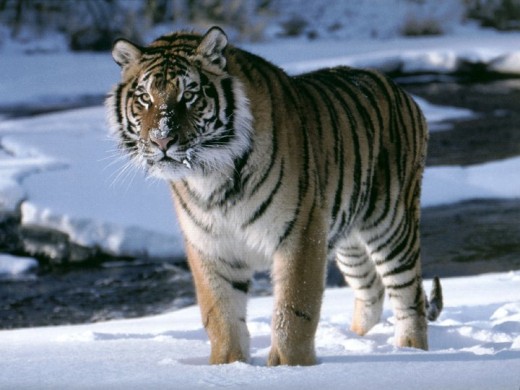 The magnificent tiger in the wild, where it belongs,
free, protected from humanity, protected from human persecution, protected from backward superstition.
A big ask of a pathogenic backward species ~ homo ‘sapiens’? The magnificent tiger in the wild, where it belongs,
free, protected from humanity, protected from human persecution, protected from backward superstition.
A big ask of a pathogenic backward species ~ homo ‘sapiens’?
.
“I hold that the more helpless a creature, the more entitled it is to protection by man from the cruelty of man”
.
“The greatness of a nation and its moral progress can be judged by the way it treats its animals.”
~Mohandas Gandhi (1869-1948)
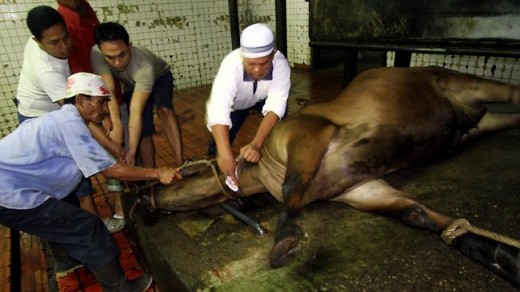 By this measure, Indonesian society’s prescription and tolerance of Dhabiha throat slitting slaughter in its abattoirs reflects a society that is barbaric, immoral, uncivilized and backward. By this measure, Indonesian society’s prescription and tolerance of Dhabiha throat slitting slaughter in its abattoirs reflects a society that is barbaric, immoral, uncivilized and backward.
.
.
Then we have the backward cultural practice of Traditional Chinese Medicine (TCM):
.
‘Diplomat exposed Chinese tiger farm horrors’
[by Jonathan Watts, 20110827, The Age newspaper, borrowed in turn from The (UK) Guardian News & Media, ^http://www.theage.com.au/environment/animals/diplomat-exposed-chinese-tiger-farm-horrors-20110826-1jefp.html, accessed 20110829]
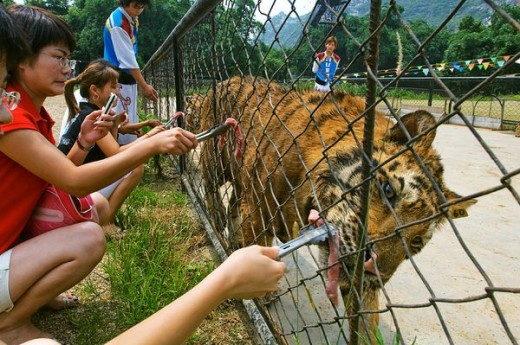 Chinese tormenting a Xiongsen Tiger Chinese tormenting a Xiongsen Tiger
.
‘An American diplomat posed as a Korean tourist to investigate a notorious tiger breeding centre in southern China, where he saw animals whipped, made to perform ”marriage processions” and reportedly sold to be used in traditional medicines.As a result of the undercover visit to Xiongsen Tiger and Bear farm, the US government was notified of doubts about China’s conservation efforts, according to a diplomatic cable recently released by WikiLeaks.
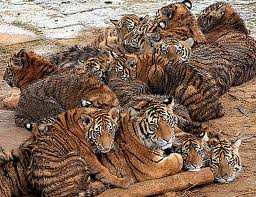 Xiongsen Tiger – a pitiful end Xiongsen Tiger – a pitiful end
The investigation was inspired by a flurry of foreign media reports in 2007 alleging the farm offered tiger meat in its restaurant and tiger bone wine in a shop.
In a cable sent from the Guangzhou US consulate headed ”Devouring Dragon, Disappearing Tigers”, an un-named economics officer said he was initially treated with suspicion by the sales personnel in the facility. But once he convinced them he was Korean, they became eager to do business.
”The staff stated that up to three tour groups of Koreans came a day, numbering more than 30 in each group.The Koreans were among the most enthusiastic purchasers of both the black bear bile and the tiger wine.” The price of the bottles ranged from 80-896 yuan ($12-$134).
 Tiger Parts used by in barbaric chinese superstition (TCM) Tiger Parts used by in barbaric chinese superstition (TCM)
.
China says it has nearly 6000 tigers in captivity, but only 50 to 60 are left in the wild. In the 1980s, China set up tiger farms to try to preserve the big cats. But conservationists have criticised the farms, accusing them of seeking primarily to produce tiger parts, which some Asians regard as aphrodisiacs.
 Packaged Traditional Chinese ‘Medicine’ Packaged Traditional Chinese ‘Medicine’
[About as effective as eating garden snails]
.
The visitor to the farm – which has more than 1000 tigers in its cages – described the spectacle of a tiger killing an ox in a ”training cage” purportedly set aside as a training area for animals that are to be introduced to the wild. But most of the animals appeared tame and some were used in circus-like entertainment shows, where they were beaten. Black bears – kept for their bile – were also made to join a mock Chinese marriage procession where they acted as bride and groom, he wrote.
 Xiongsen Bear and Tiger Mountain Village
(a backward cruel colosseum for human hedonistic animal sadism) Xiongsen Bear and Tiger Mountain Village
(a backward cruel colosseum for human hedonistic animal sadism)
.
Locals told him that the farm served tiger meat and sold tiger skin, but this was denied by staff.
Nonetheless, he concludes in the cable dated July 12, 2007, that:
”The commercial nature of the farm was troubling. The large number of endangered tigers and bears present with no current plans to reintroduce them into the wild raises concern regarding the motivation of such a farm.”
.
Four years later, these concerns remain valid. Reports earlier this year suggest the tiger population of the farm has grown.’
.
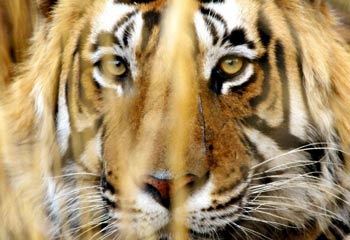 A threatened and persecuted species by backward human cultures,
reduced to the mercy of civilized humanity’s compassion and whim. A threatened and persecuted species by backward human cultures,
reduced to the mercy of civilized humanity’s compassion and whim.
.
 Gong Xi Fa Cai
[Chinese Year of the Tiger ~ a harbinger of mass slaughter] Gong Xi Fa Cai
[Chinese Year of the Tiger ~ a harbinger of mass slaughter]
.
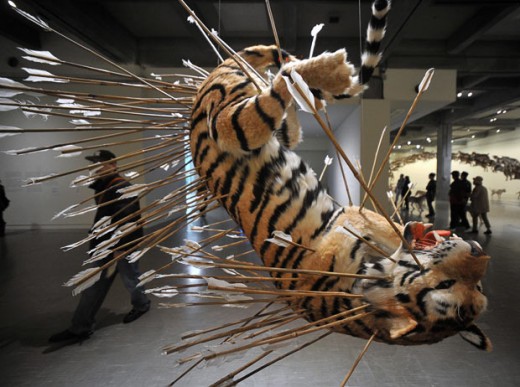 2010 was the Chinese Zodiac Year of the Tiger 2010 was the Chinese Zodiac Year of the Tiger
.
.
Footnote
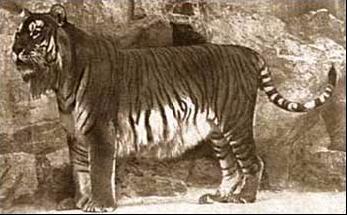 Rare photo of a Caspian Tiger Rare photo of a Caspian Tiger
.
Until the 19th century, Caspian tigers still inhabited wide spaces of Western and Central Asia. In the mid-19th century, Caspian tigers were killed 180 km northeast of Atbasar, Kazakhstan and as far North as near Barnaul, Russia.
The only reported Caspian tiger from Iraq was killed near Mosul in 1887. In 1899, the last Caspian tiger near the Lop Nur basin in Xinjiang, China, was killed. Caspian tigers disappeared from the Tarim River basin in Xinjiang, China, by the 1920s.
The last record of the Caspian tiger on the Ili River, their last stronghold in the region of Lake Balkhash, Kazakhstan, dates to 1948.
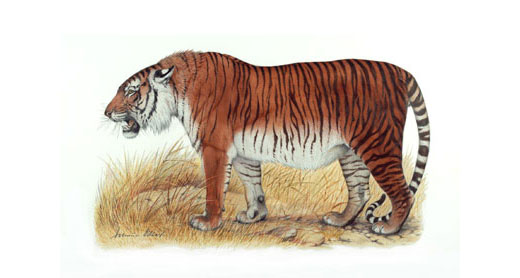 Caspian Tigers now are extinct. They only exist in illustration. Caspian Tigers now are extinct. They only exist in illustration.
.
.
– end of article –
Tags: backward cultures, Chinese Tiger Farm, Dhabiha, Indonesian abattoirs, TCM, tiger bone, tiger parts, Traditional Chinese Medicine, WikiLeaks, Xiongsen Bear and Tiger Mountain Village, Xiongsen Tiger, Xiongsen Tiger and Bear farm, Xiongsen Tiger Mountain Village
Posted in Threats from Poaching and Poisoning, Tigers | 1 Comment »
Add this post to Del.icio.us - Digg
Leave a Reply
You must be logged in to post a comment.
August 28th, 2011
The following article was initially published by Tigerquoll on CanDoBetter.net 20090416 under the title: ‘ACT Environment Commissioner unqualified to condemn kangaroos’:
.
One day kangaroos grazing on Australian grasslands (long deforested by colonists)…
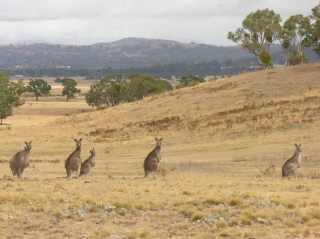
Next day, thanks to the ACT Commissioner for Sustainability and the Environment….
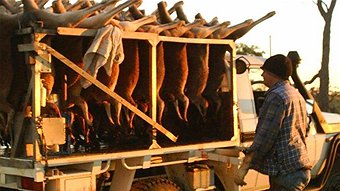
ACT Commissioner for Sustainability and the Environment, Dr Maxine Cooper, is the Australia Capital Territory’s inaugural full-time Commissioner in the role, yet what relevant environmental qualifications and experience does the incumbent have, or indeed lack, to be officially condemning another local indigenous population of Australia’s iconic marsupials, our kangaroos, to slaughter for pet food?

The Environment Commissioner’s own website lists her formal qualifications in the areas of:
- Environmental Planning
- Environmental Design
- Environmental Science
.
All these ‘environmentally’ friendly prefixes sound impressive, until one realises that each of these areas of academic study are not fauna focused, but indeed are all about human-centric utilisation of the natural environment for the benefit of humans. That is, these qualifications are all about maximising the convenience of the environment for humans. A wolf in charge of the kangaroos? It’s just like forestry pretending to care about forests.
Such qualifications offer no insight into the survival and habitat needs of Australian wildlife. “According to ACT’s inaugural Environment Commissioner, kangaroos at Belconnen were a threat to certain vulnerable and endangered species of fauna and flora on the site. Where’s the bloody independent zoological evidence, who would attest to this view under the test of peer scrutiny?
Now if our roo-shooting redneck commissioner had a more relevant Bachelor of Science in Zoology from say the University of Melbourne, she may be of a contrary mindset and less aligned to human planning needs and monetary gains; instead more empathetic to ecological needs of native fauna. The introductory paragraph for the University of Melbourne’s Honours degree in Zoology instills the following focus:
.
“How animals live and why they live that way are questions addressed by zoologists. Most of the Australian fauna are poorly understood or not even formally named, yet informed management and resource use of Australia’s flora, fauna and habitats depend upon zoological knowledge. We need to catalogue what species exist and how they survive in their natural environments. This requires knowledge of their physiology, breeding and reproductive systems, ecology, evolution and behaviour.”
[SOURCE: http://www.unimelb.edu.au/HB/areas/SZOOL.html]
Maxine Cooper, where are your qualifications in Zoology, in Conservation and in Australian wildlife to entitle you to officially condemn thousands of Australia’s iconic kangaroos to slaughter for cat and dog food?
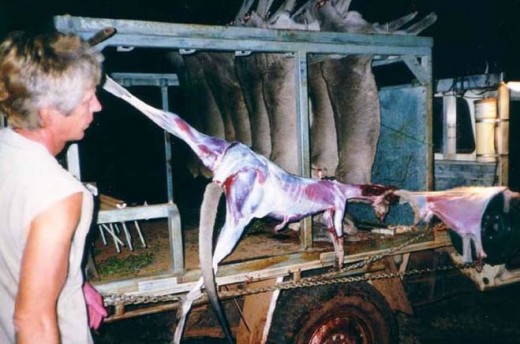
Can you guarantee the Australian public that none of these kangaroos is to be minced for cat and dog food?
The standard setting for the job prerequisites for the ACT’s Environment Commissioner are woeful and clearly not in the best interests of the target subject – our natural wildlife. What were they thinking by employing a planner in environmental management?
.
.
.
Editor’s comment:
.
The stated role of the OCSE is to:
.
- ‘Investigate complaints about the management of the environment by the Territory or a Territory authority’
- ‘Conducts investigations as directed by the Minister’
- ‘Initiates investigations into actions of an agency where those actions would have a substantial impact on the environment of the ACT’
- ‘Produces state of the environment reports for the ACT and the 17 councils in the Australian Capital Region’
- ‘Makes recommendations for consideration by government and includes in our annual report the outcomes of those recommendations’
- ‘Resolves issues through mediation and conflict resolution’
- ‘Undertakes an advocacy and awareness role on sustainability and environmental issues.’
.
[Source: OCSE website, ^http://www.envcomm.act.gov.au/our_office]
.
So it basically seems to be an ACT Government environmental watchdog agency. Why?
The ACT covers only 2400 square kilometres and has under 400,000 people. It already has an Environment and Sustainable Development Directorate [Read More], which lumps disparate functions under one watered down super-ministry including environment, water, climate change, planning (including development assessment, leasing, construction, land use and utilities regulation, surveying and land information), the Government architect, heritage, transport planning and nature conservation.
So is OCSE the watchdog for one overburdened super-ministry? It is bureacracy gone mad. Since Canberra is the seat of the federal government and ACT is so small, why not just have the Federal Government look after ACT conservation matters and be cost effective with taxpapers’ money?
.
It is gross deceptive greenwash when the Australian Capital Territory government merges all its conservation responsibility into one super agency, The Office of the Commissioner for Sustainability and the Environment, (OCSE), then heads it up with a town planner [Read More], then tries to claims that it has custodial responsibility for environment and conservation on behalf of the people of the ACT. It is wholly consistent with government’s misuse and abuse of the word ‘sustainability‘ ~ to mean any action that sustains the government’s conveniences and political ends, such as land use development of grasslands for industry. The Office is simply a development planning arm of the ACT Government and many Canberra-based property developers are very happy with the arrangement thank you very much.
But it is the biased leading the inept when one reads a report, ‘Report of the Grassland Forum‘ dated 20 May 2010 on the website of this Office of the Commissioner for Sustainability and the Environment.
The report considers the future potential of the 10,000 hectares of native grassland just outside Canberra.
This report was not compiled not internally (probably because the OCSE employs not competent environmental scientists to do so), but believe it or not by a property development consulting firm ‘Beaconhill Consulting‘. ‘Beaconhill Consulting’s recent work is listed on its website as:
- Strategic performance review of a major multi-program investment portfolio valued at several hundred million dollars
- Due diligence examination of a multi-million dollar import business investment – supply chain and market analyses, review of product efficacy and policy framework
- Strategic Business Development for an emerging export business – Board level reforms and strategies, business plan development, commercialisation strategy, marketing plans, industry development application, governance arrangements and commercial partner negotiations
- Business Development, government submissions, marketing plans, and client tenders.
.
The ‘Report of the Grassland Forum’ “found that the Eastern Grey Kangaroos are the dominant herbivore in natural grasslands..and that their overgrazing has lead to erosion and loss of plant species“.
It is not surprising that the Maxine Coopper’s office has approved many hundreds of these native kangaroos have been conveniently slaughtered for pet food. Some nutter has even contrived a myth that these grazing native kangaroos are threatening the survival of a rare native Earless Dragon in the area. Kangaroos threatening native animals! That’ a cracker! The fact that thousands of hectares of these grasslands are planned for bulldozing to make way for industrial and residential development may not threatend the Earless Dragon is not mentioned in the report.
It is laughable to read terms such as ‘diversity‘ and ‘ecology‘ used in the report in the context of industrial development.
The study focused upon Canberra restricted supply and diversity of industrial land. It is considered that Eastern Broadacre will play a critical role in meeting Canberra’s industrial needs in the long term. The study found that possible uses include:
- Freight/ transport and logistics
- Industrial and associated office
- Warehousing/ storage
- Education and training facilities
- Tourism/ recreational uses
‘Belinda explained that the sustainability corridors may have broader considerations, and ACTPLA is keen to explore light industry ecology.’
.
[ Read Report]
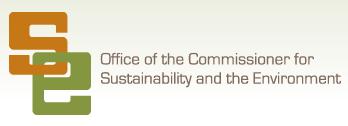
So this is where the tax revenue of the people of Australia’s Capital Territory around Canberra is being spent. How much did this report cost? How much did the OCSE logo above cost – took a lot of imagination that one!
Tags: ACT bureaucracy, ACT Commissioner for Sustainability and the Environment, ACT taxpayers money wasted, Dr Maxine Cooper, Eastern Broadacre, Eastern Grey Kangaroos, Environment and Sustainable Development Directorate, greenwash, kangaroo meat, kangaroo pet food, kangaroo slaughter, Report of the Grassland Forum, save the kangaroo, the biased leading the inept, Visit Canberra
Posted in Kangaroos and Macropods, Threats from Poaching and Poisoning | No Comments »
Add this post to Del.icio.us - Digg
Leave a Reply
You must be logged in to post a comment.
|
|
 Woodchipping Tasmania only benefits foreign buyers, who must be laughing
Woodchipping Tasmania only benefits foreign buyers, who must be laughing
 Extinction is forever ~ the dark past should not curse our future
Extinction is forever ~ the dark past should not curse our future Tasmanian History in the making
Tasmanian History in the making
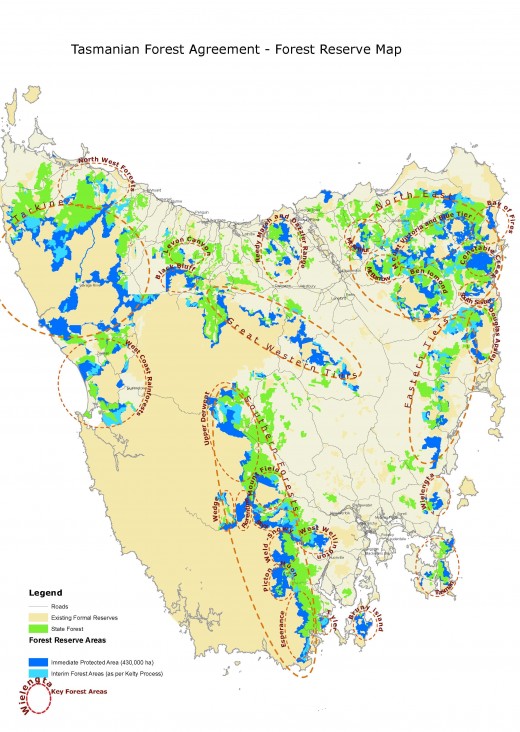 >Read Larger Detailed Map
>Read Larger Detailed Map High value-add Electric Guitar in Tasmanian Myrtle
[Source: ^http://tasmaniantonewoods.com/guitars]
High value-add Electric Guitar in Tasmanian Myrtle
[Source: ^http://tasmaniantonewoods.com/guitars]
 Tasmanian Premier and Treasurer, Lara Giddings
Photo courtesy of The Hobart Mercury
Tasmanian Premier and Treasurer, Lara Giddings
Photo courtesy of The Hobart Mercury





































































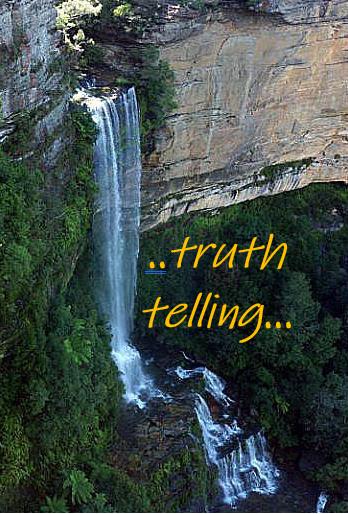





This is absolute crap, I am a Zimbabwean and living in Australia. The last thing I want is Australians going to my Country and killing our majestic animals such as this.